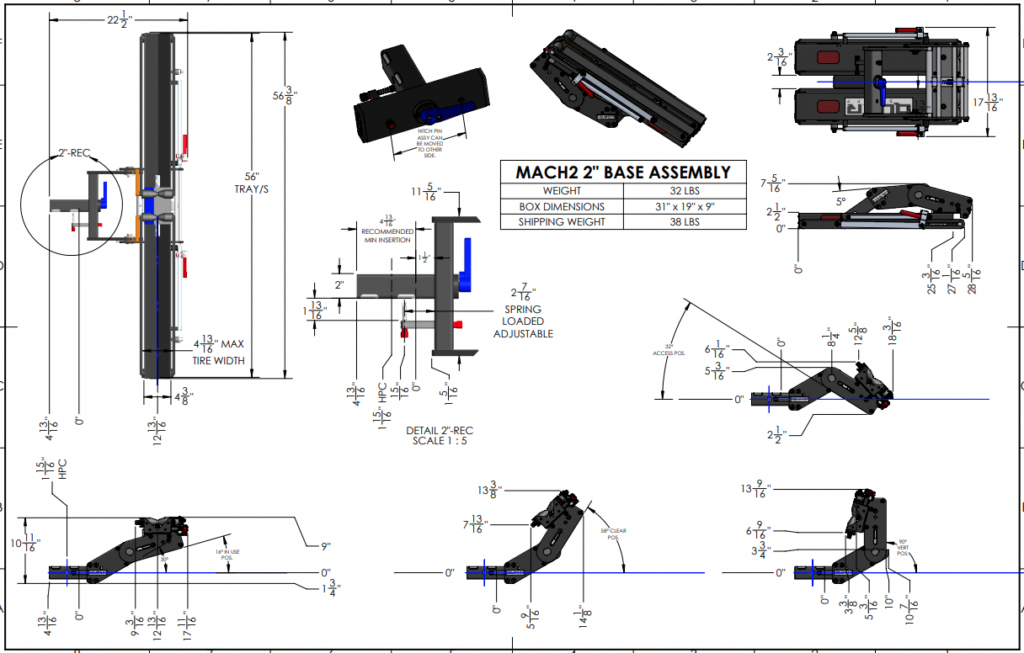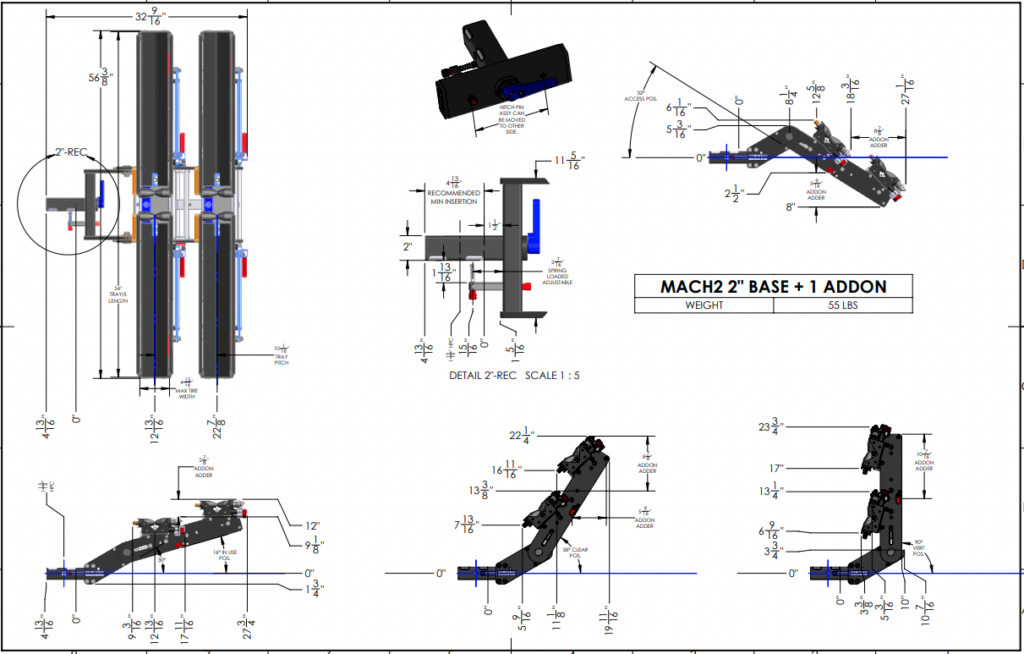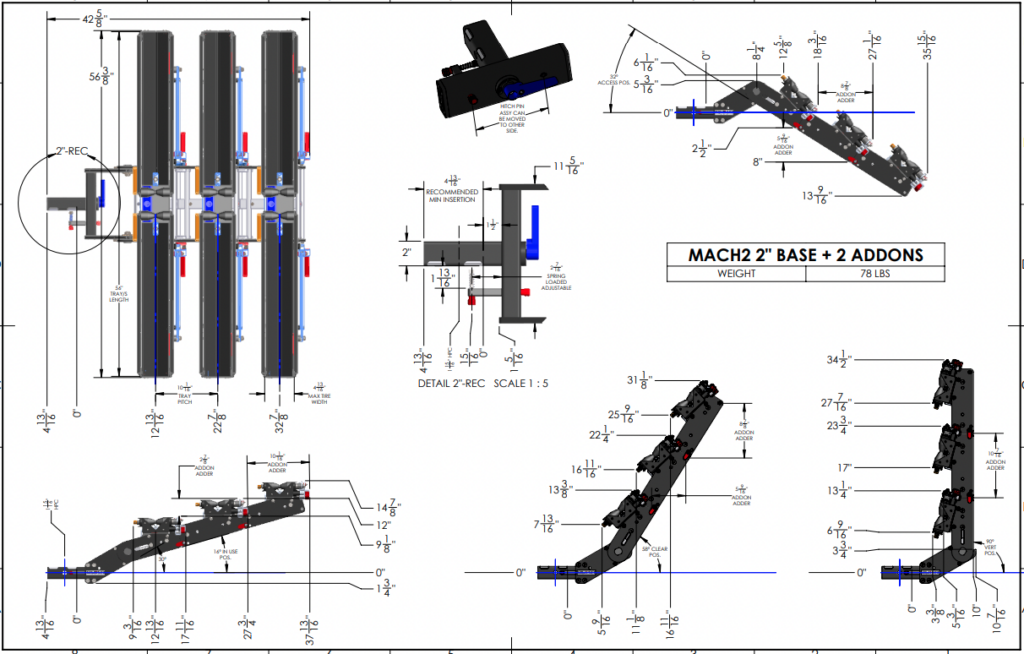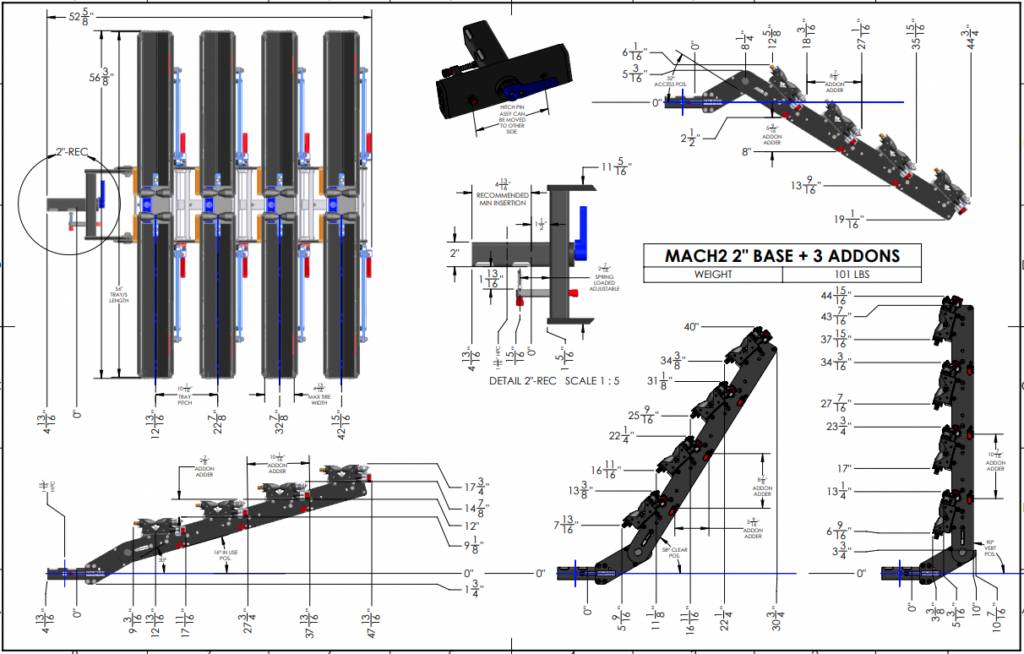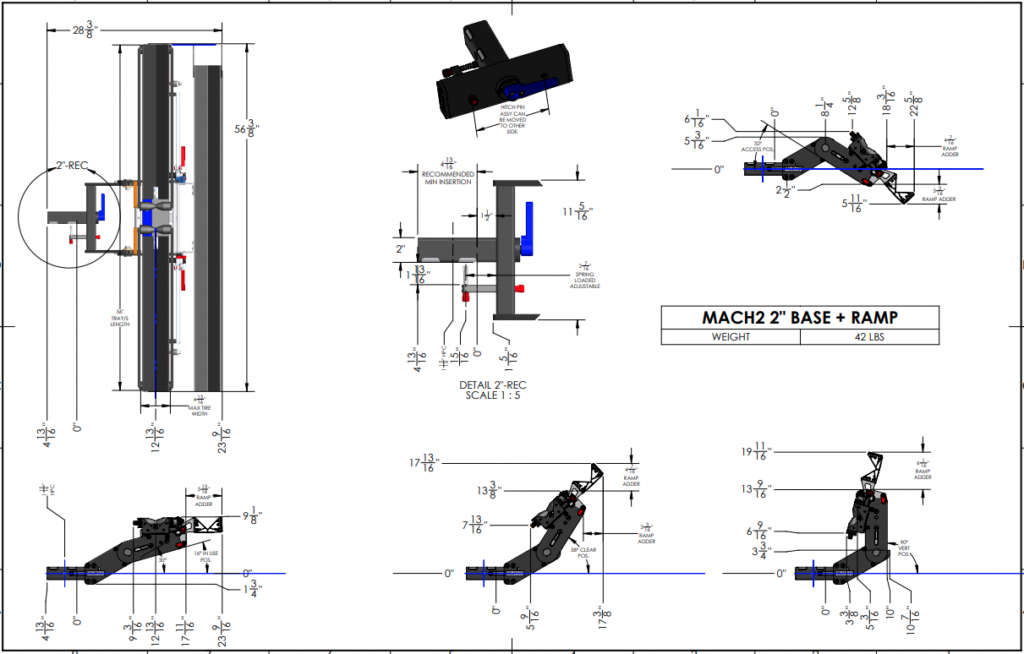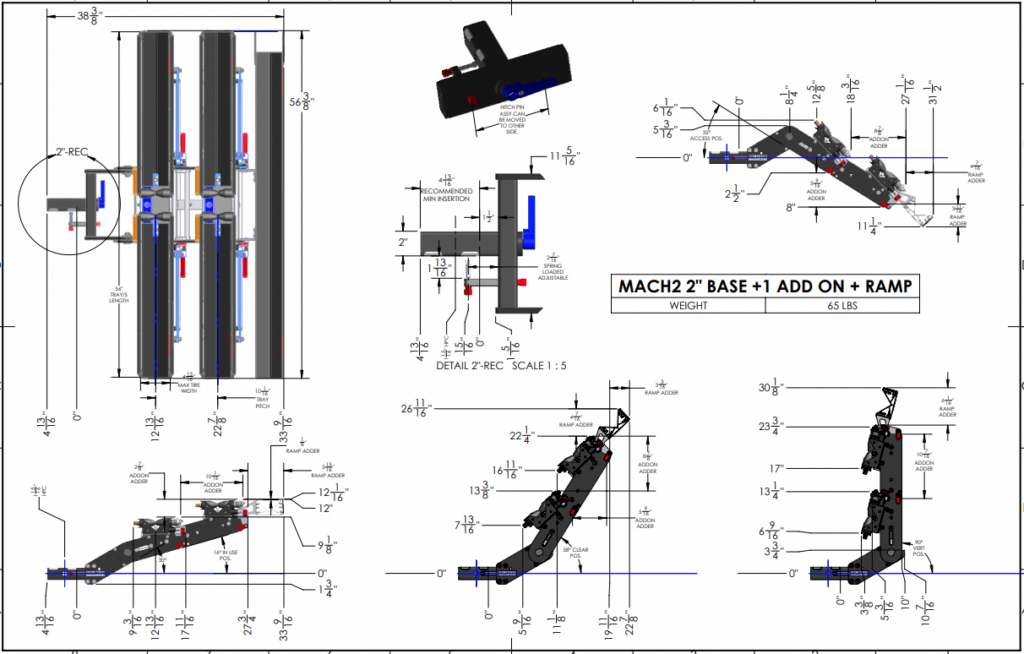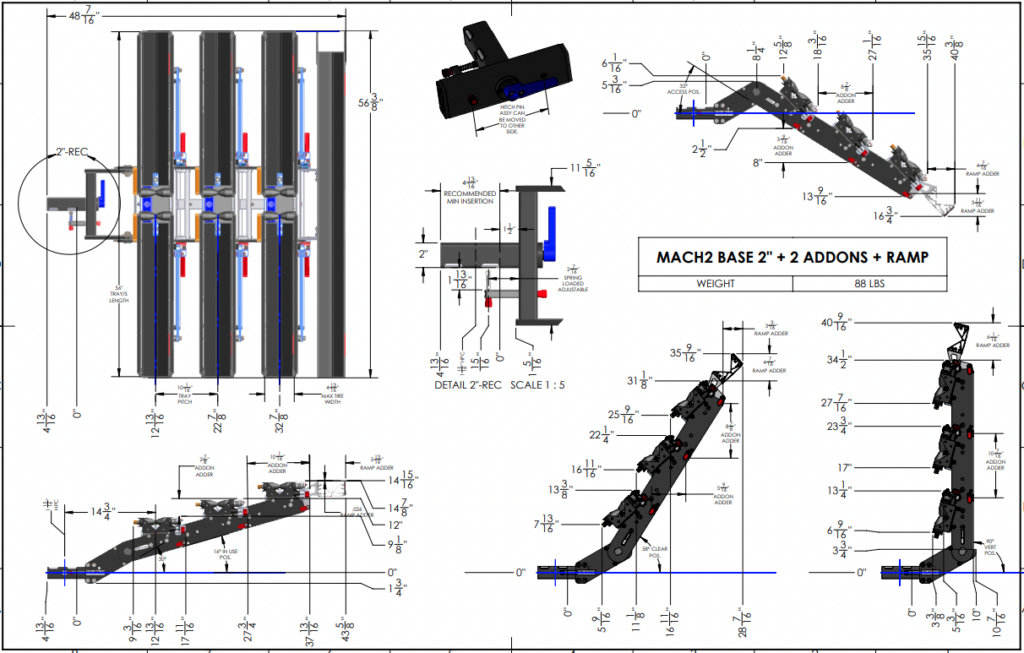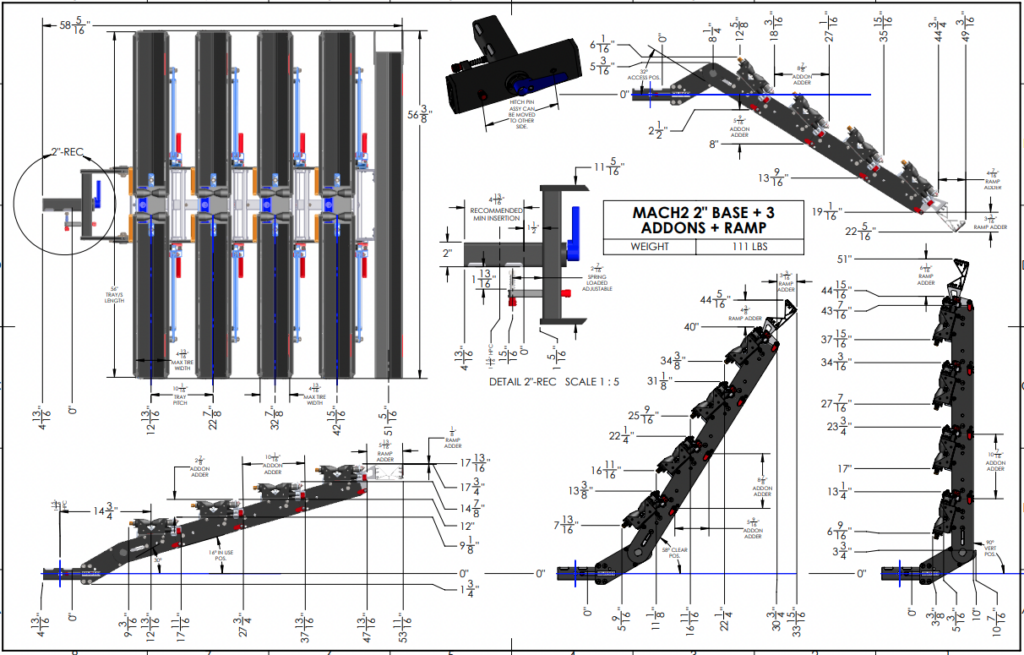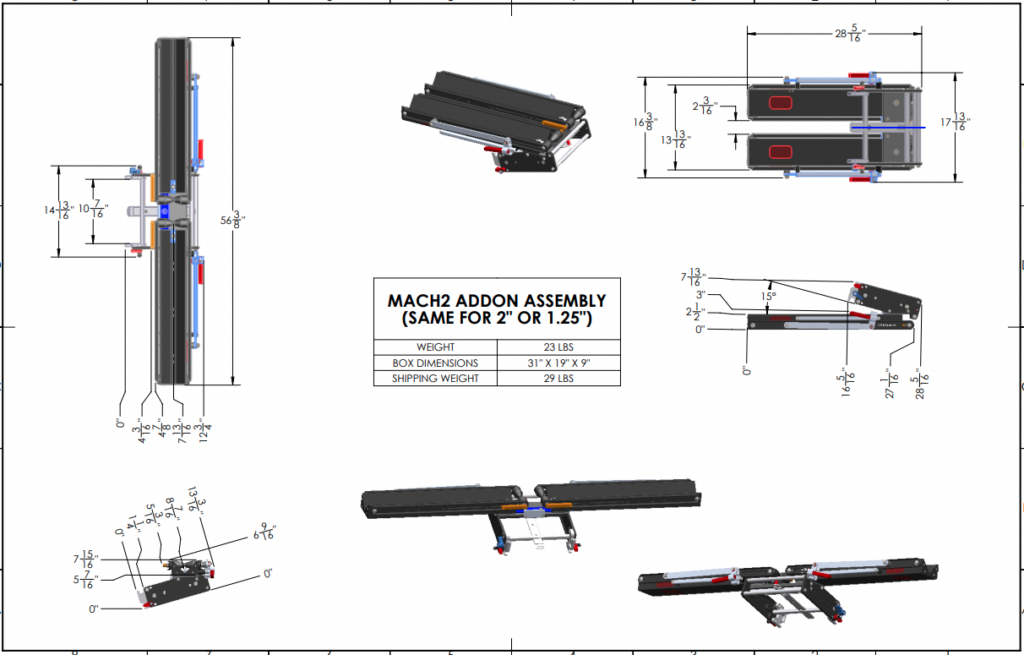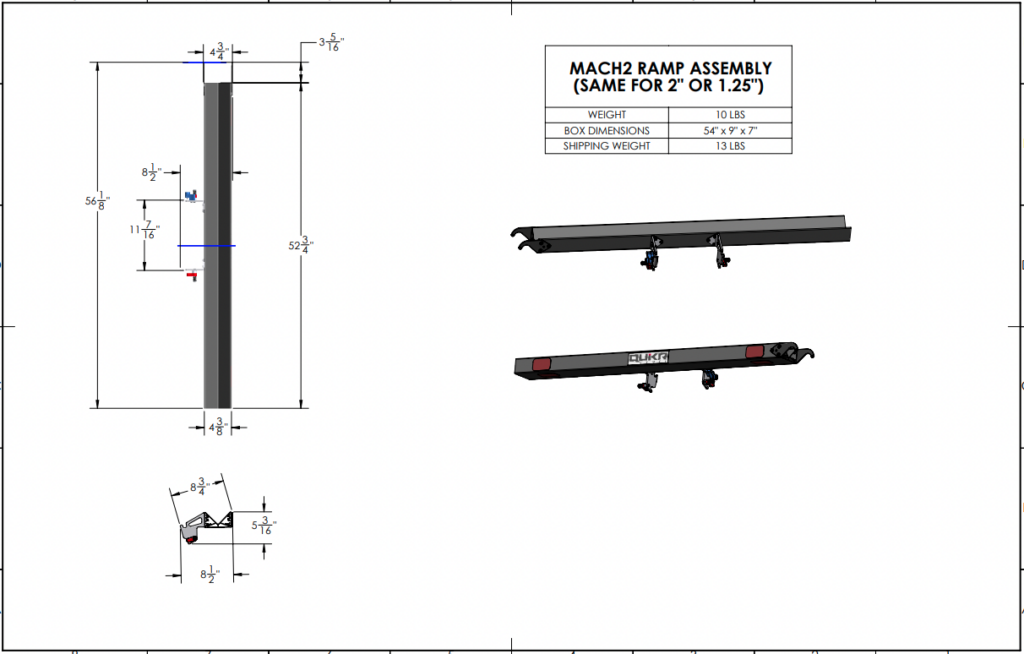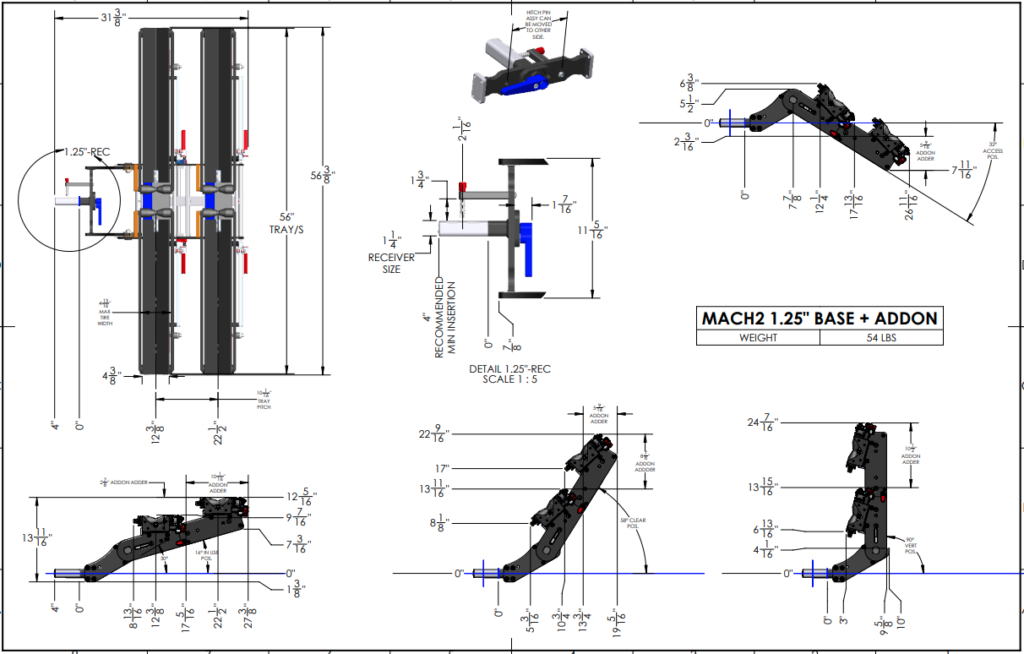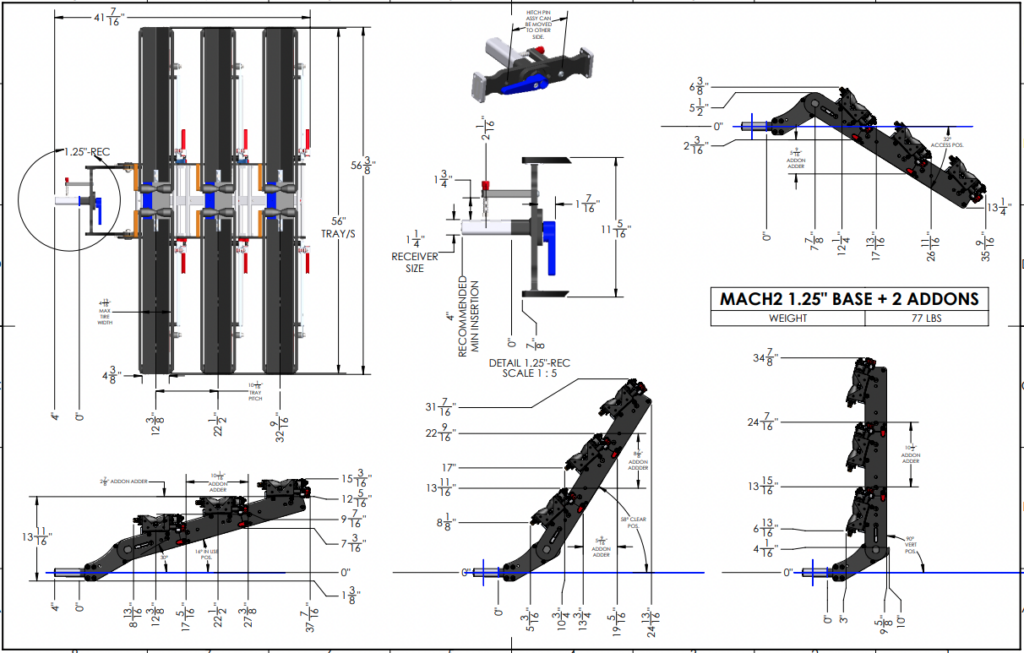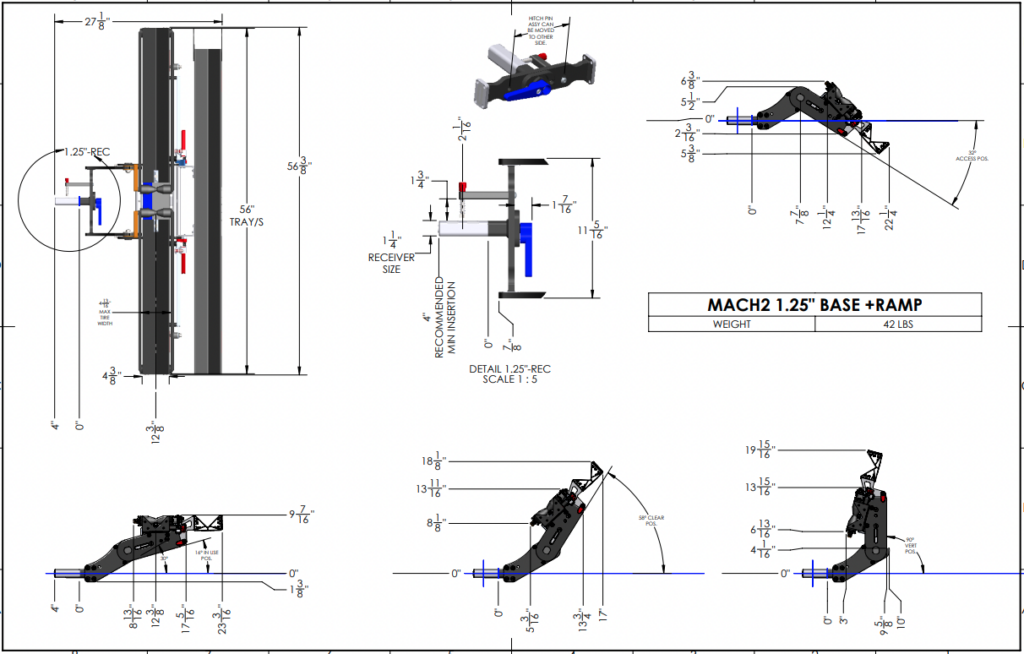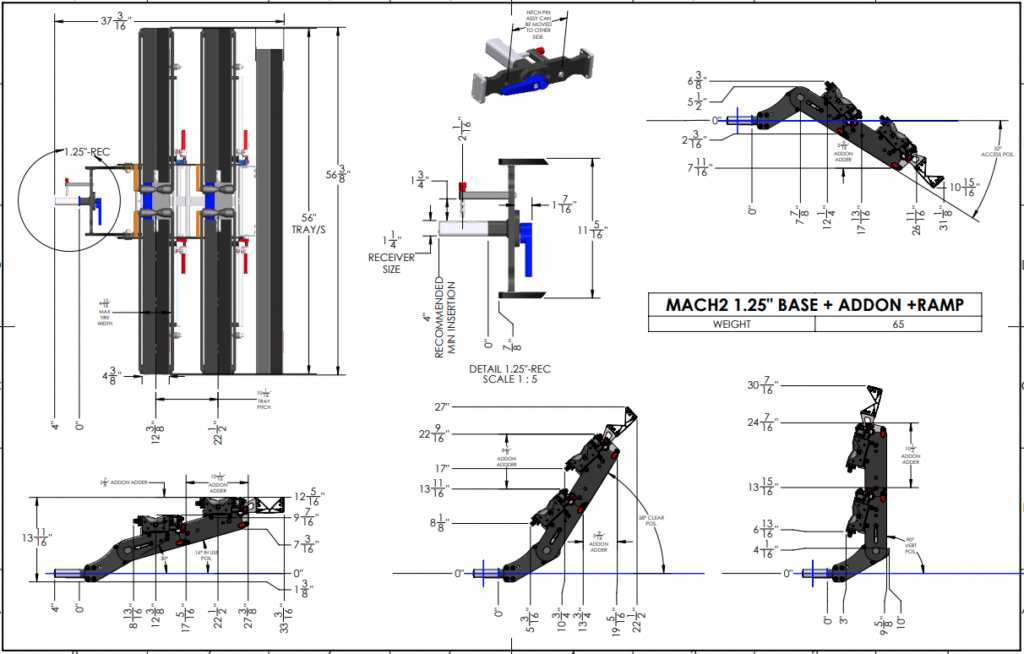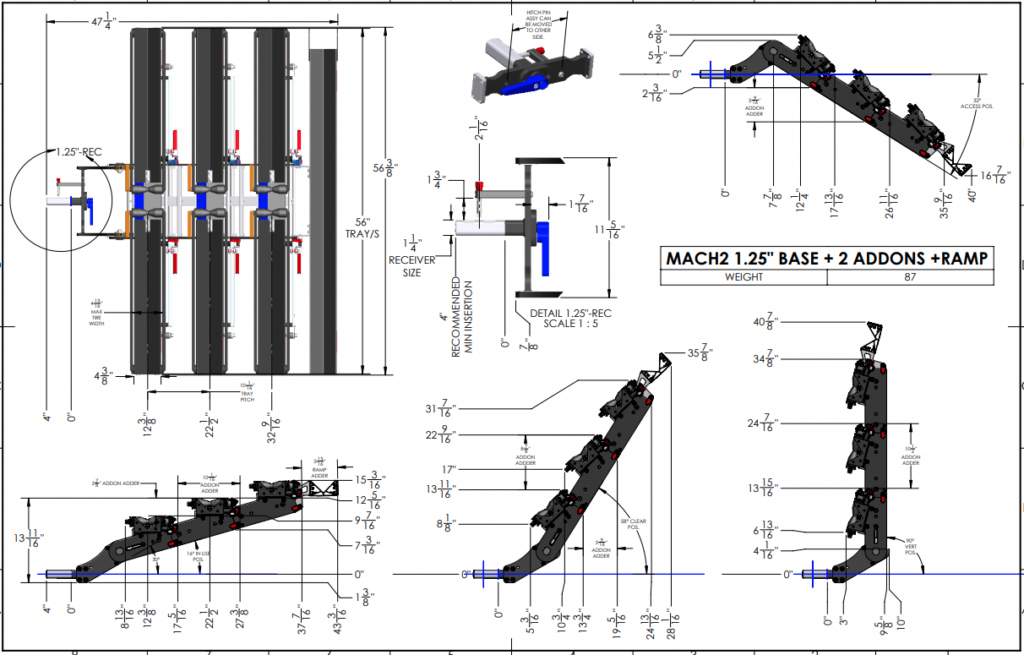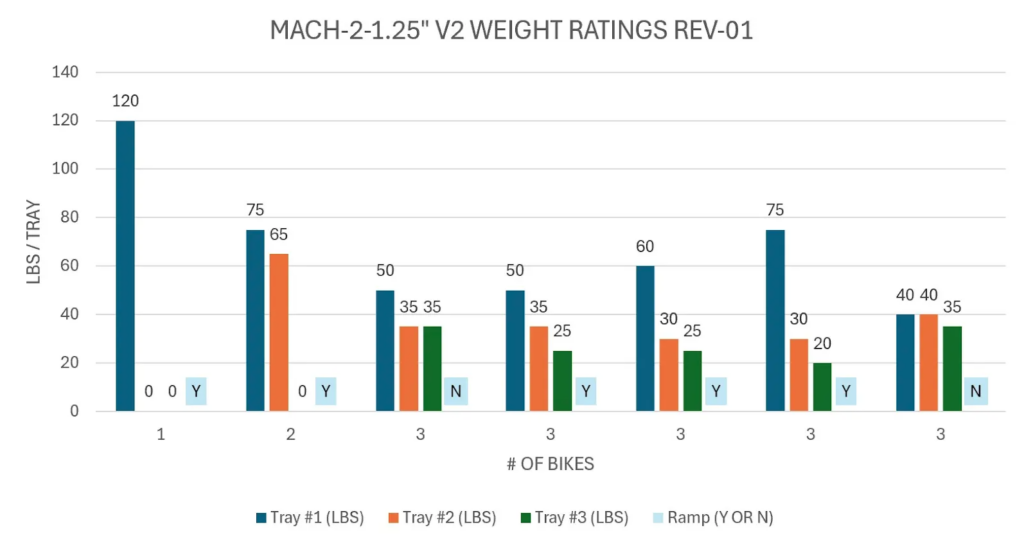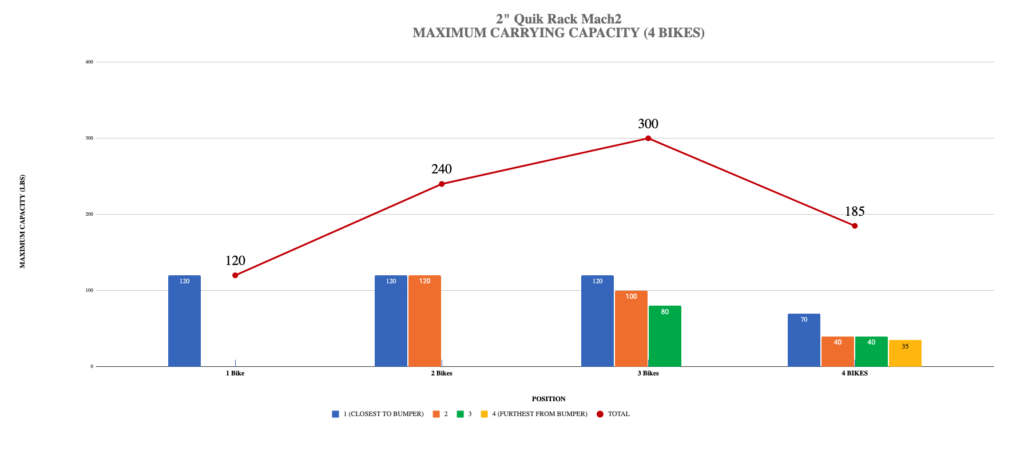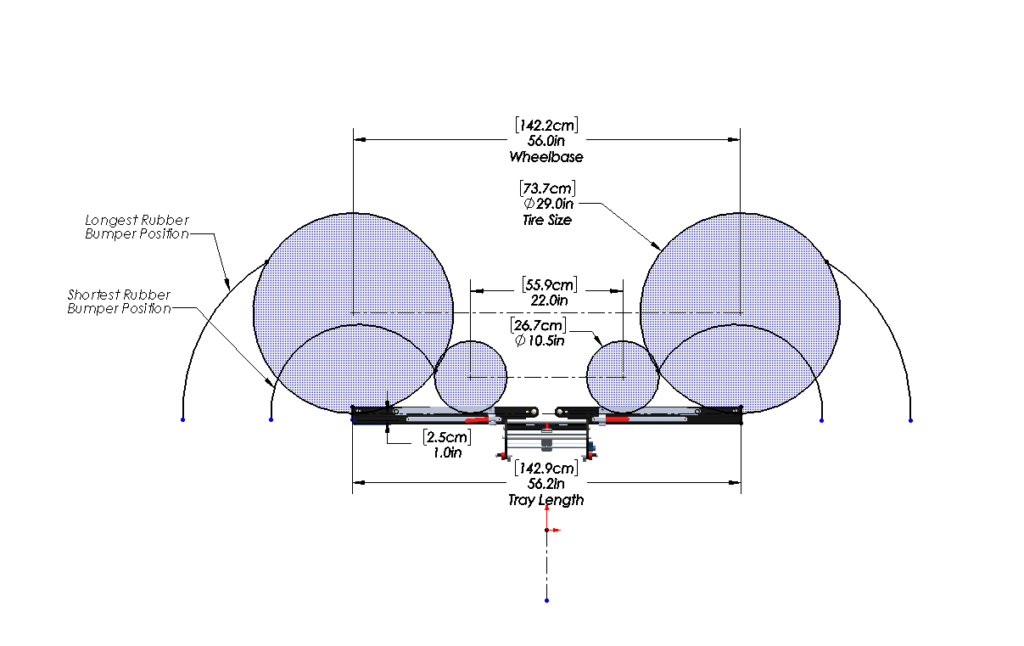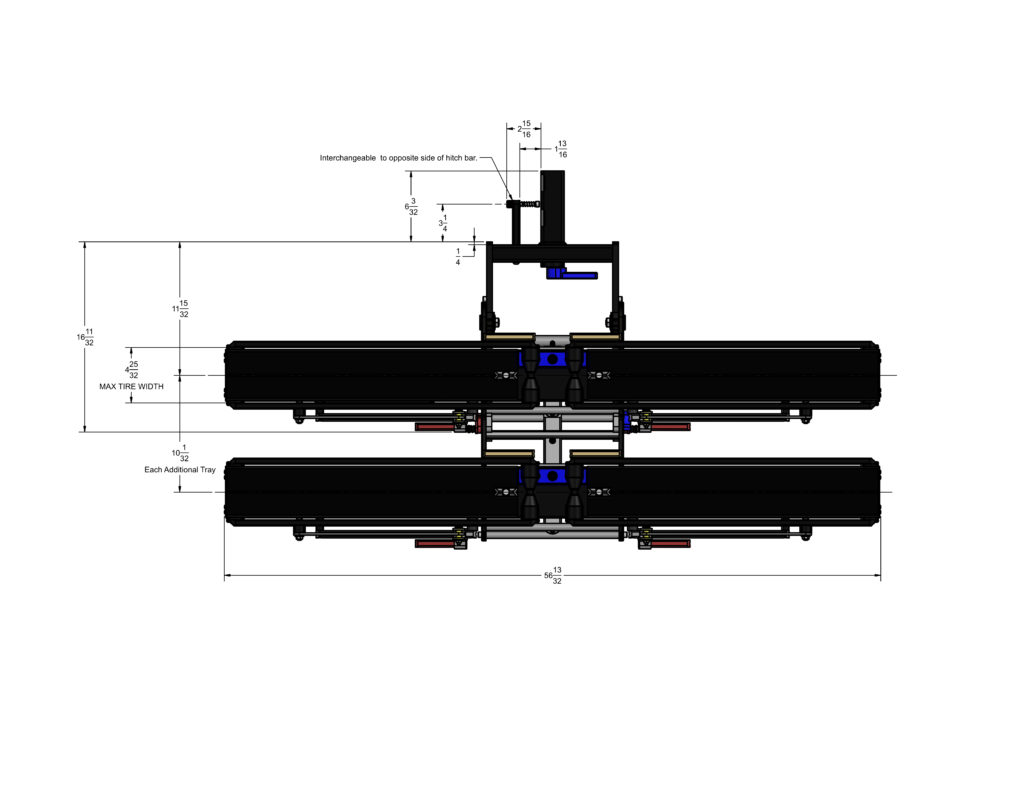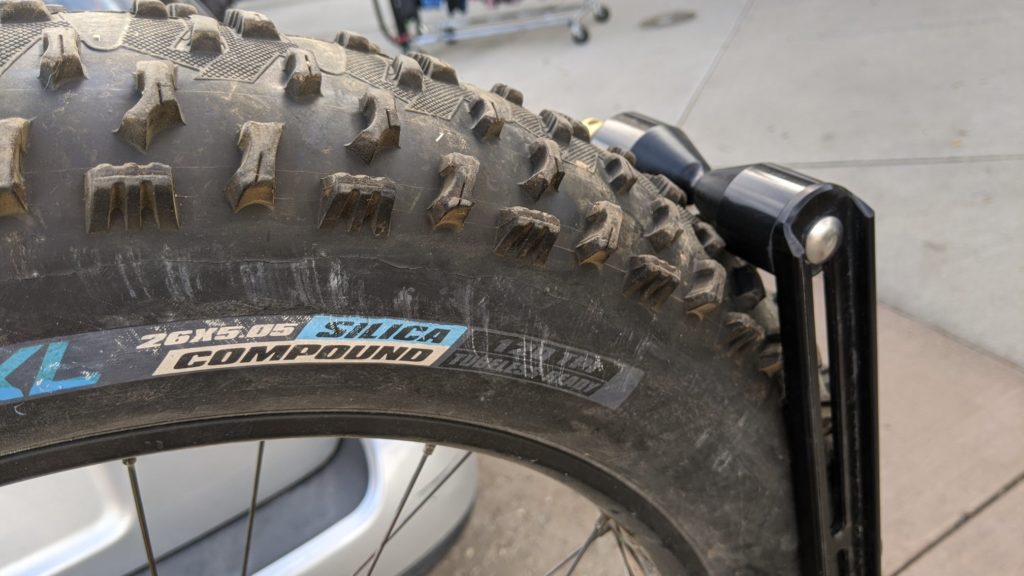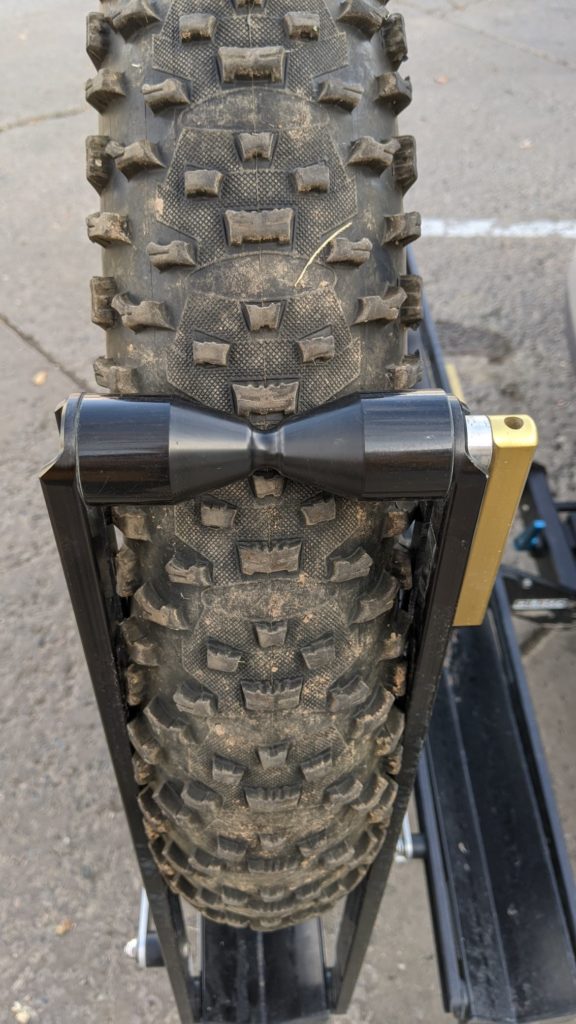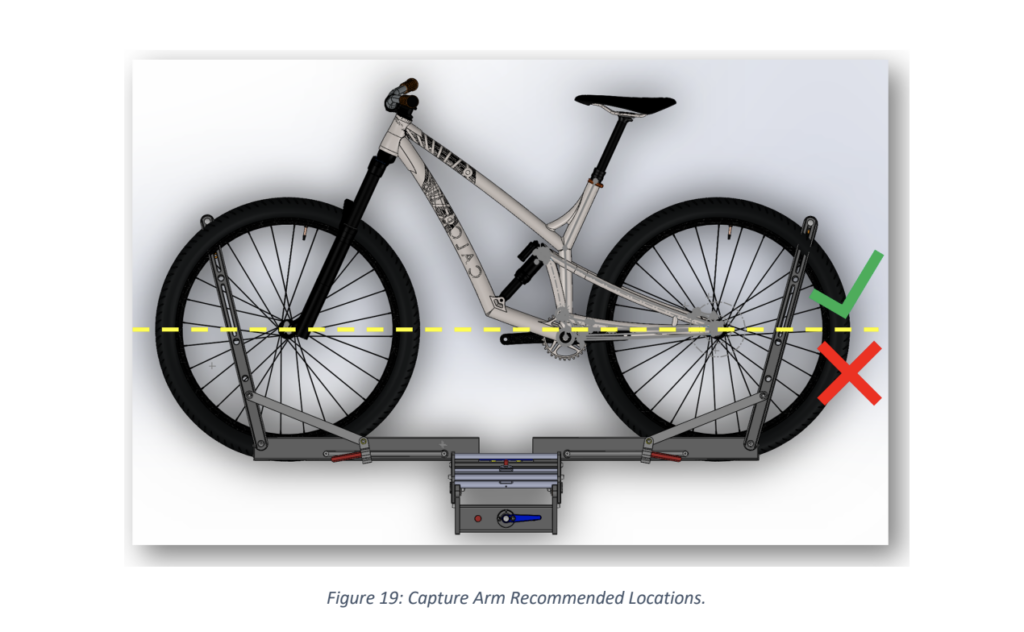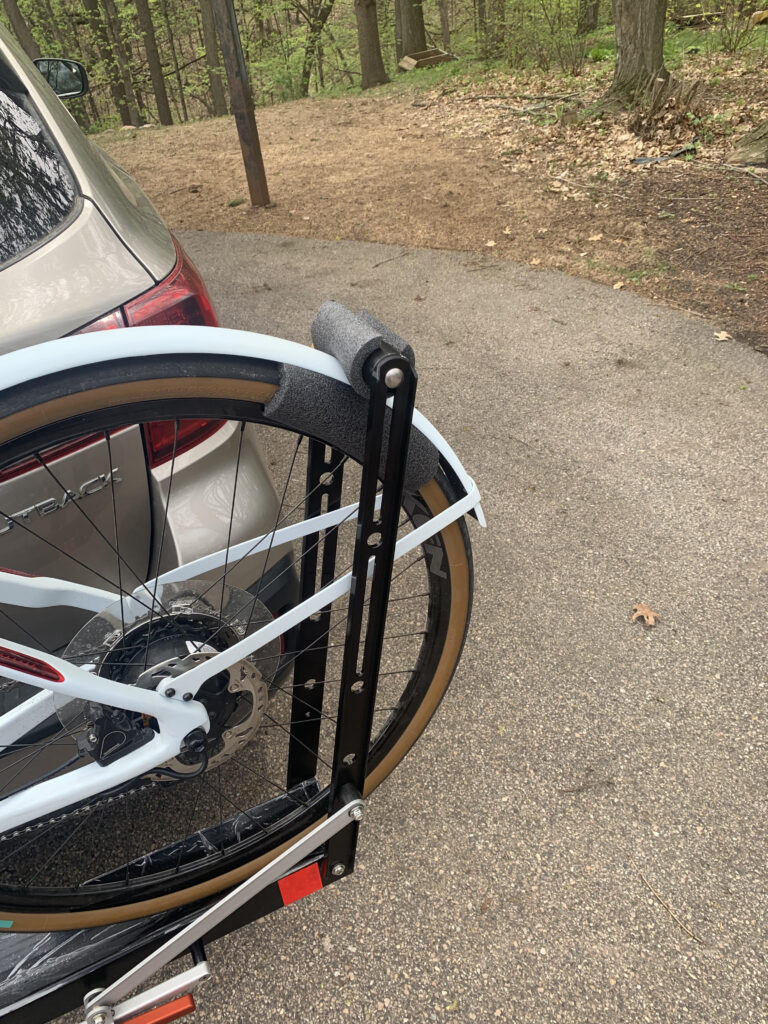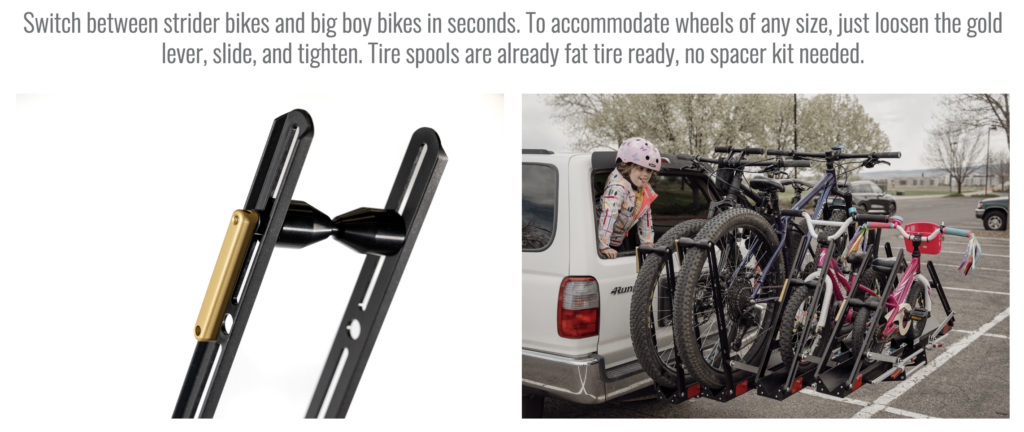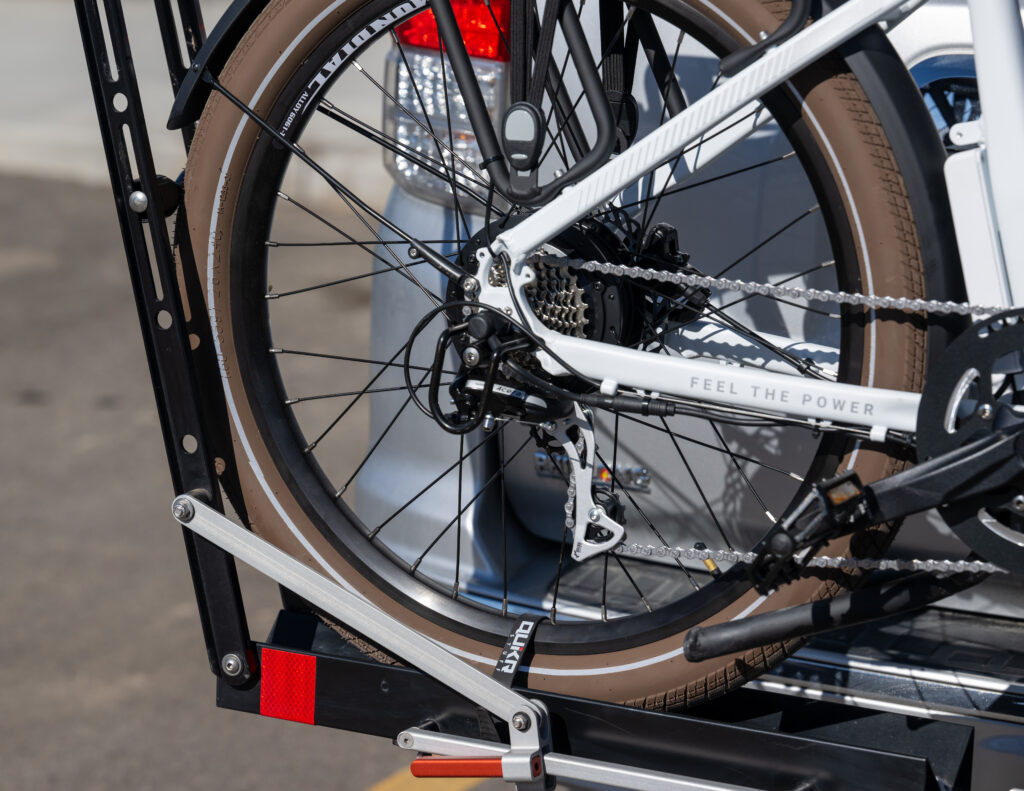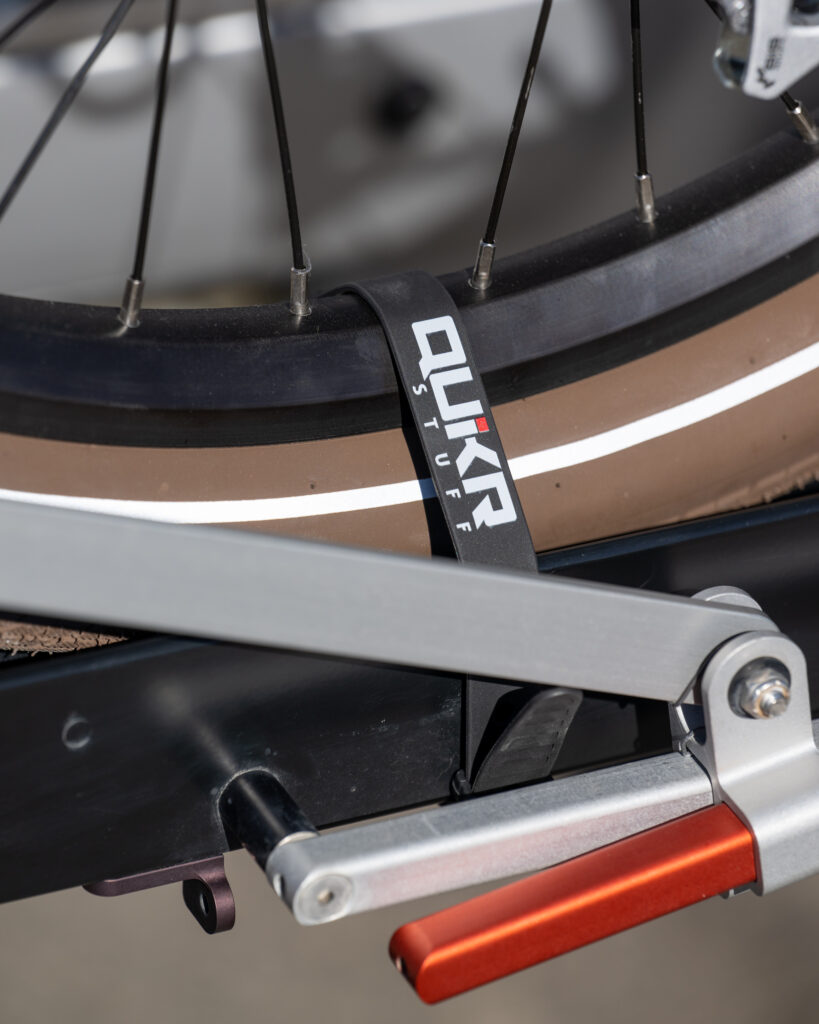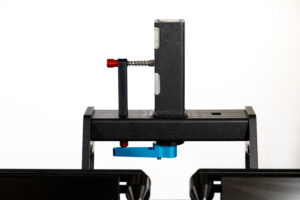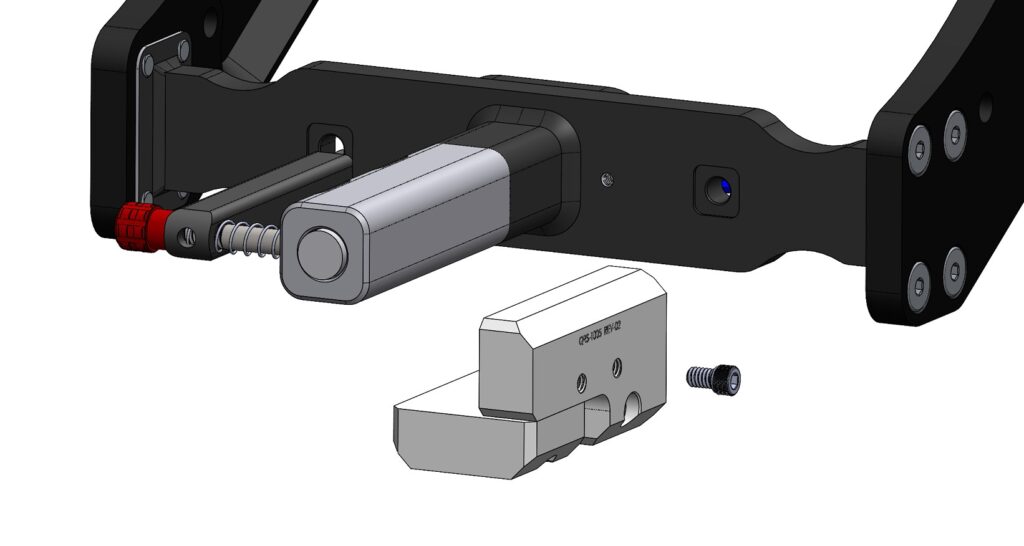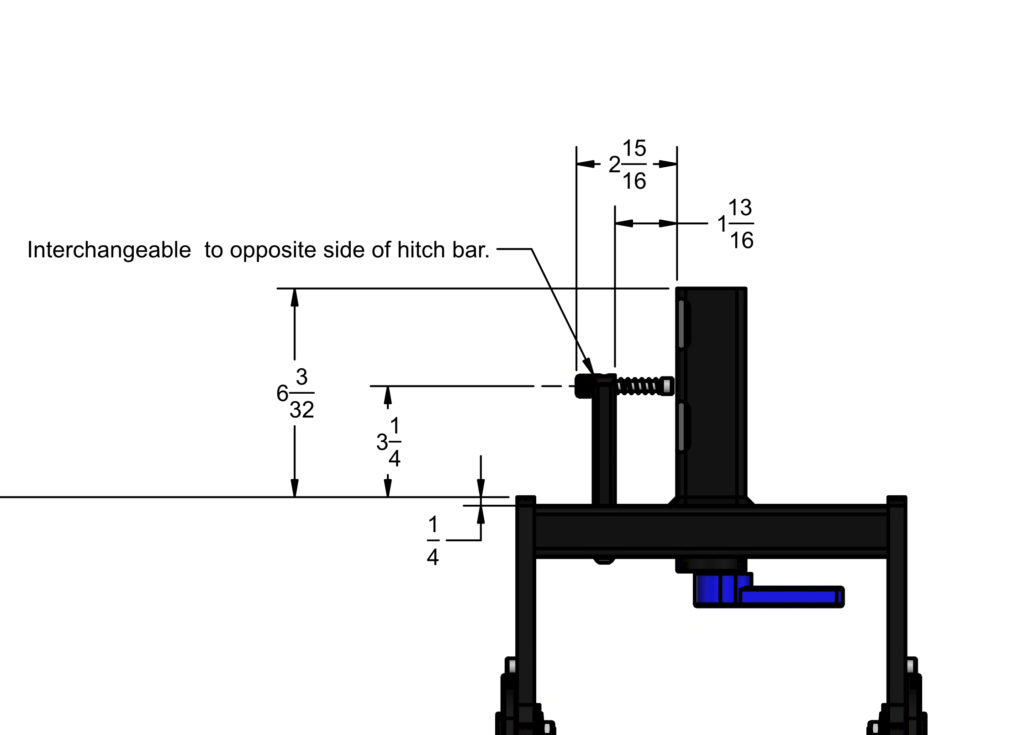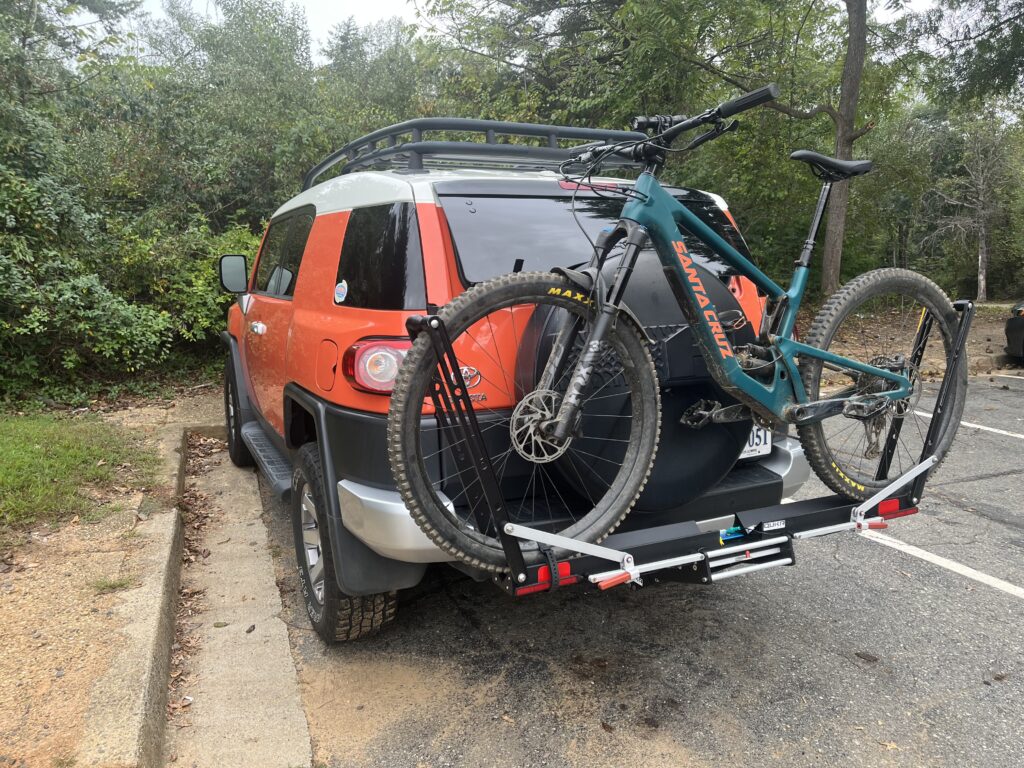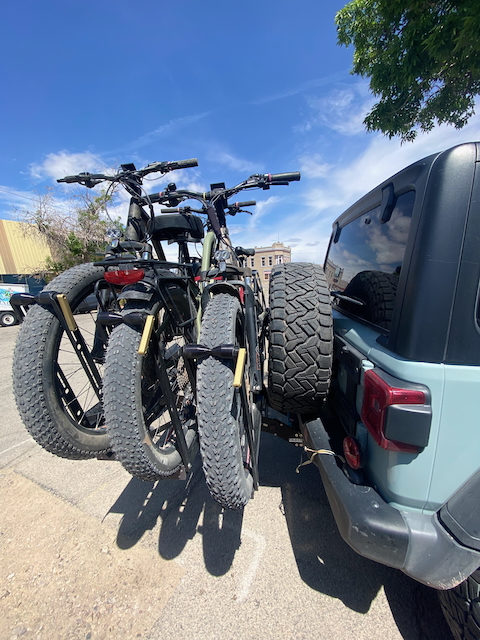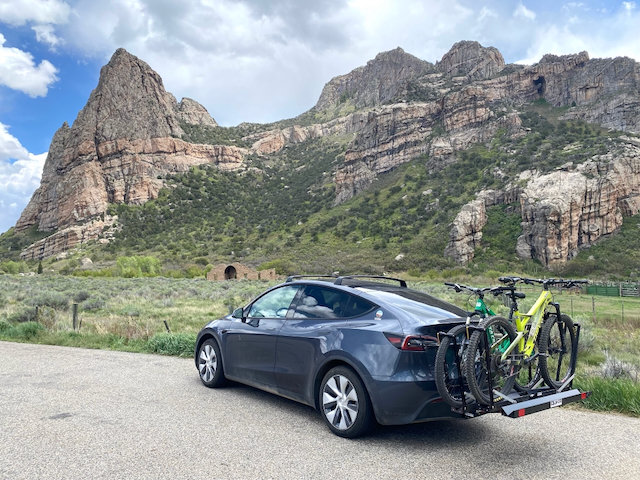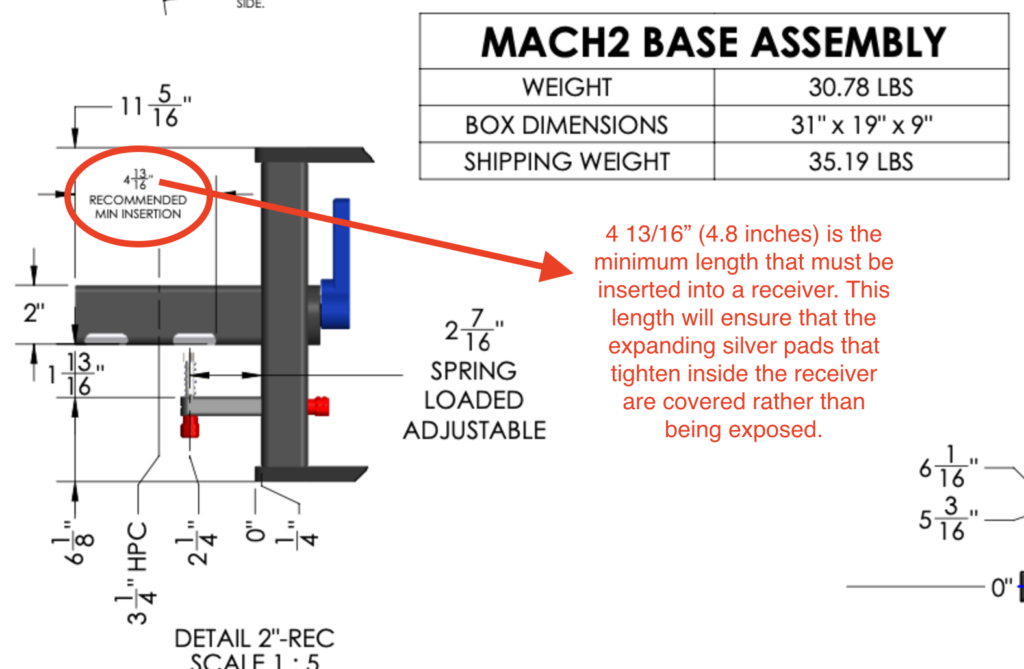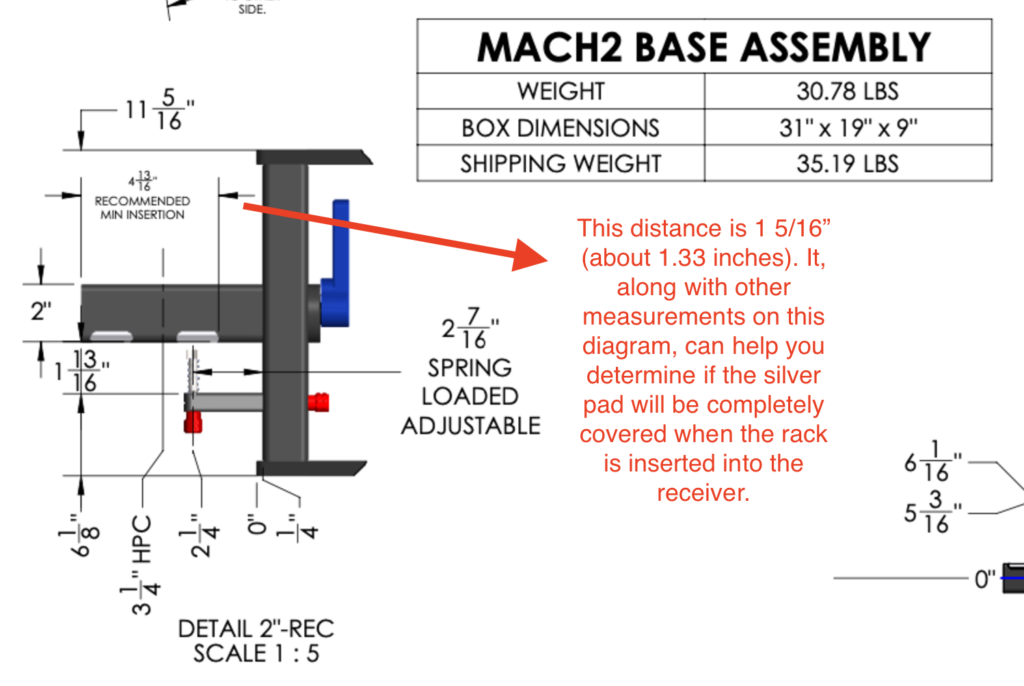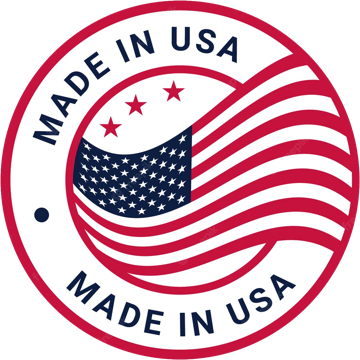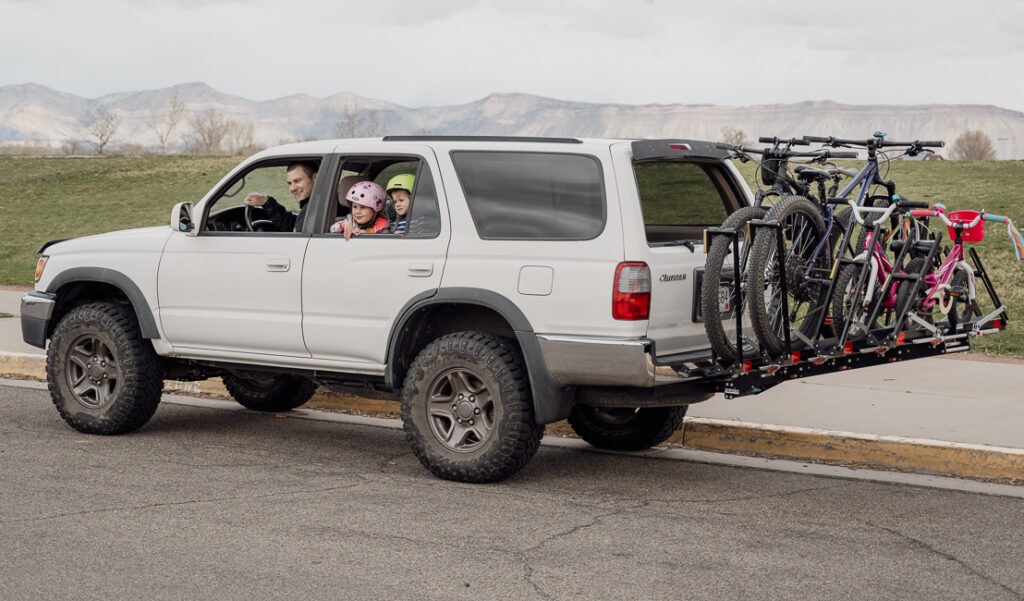
FAQ/Patents
For Quikr self-help, please scroll and expand (+) questions to find your answer, and/or search the page for your question using the CTRL + F keys (PC) or Command (⌘) + F keys on a Apple Mac.
Current Shipping and Payment Questions
UPDATED DECEMBER 2024
We cannot guarantee fitment of the rack on your vehicle because there are too many changes in variables in model spec, OEM (original equipment manufacturer), and aftermarket hitches and adapters, as well as way too many vehicles to keep up a database. Instead, we provide for you here the information you need to measure and make a determination yourself. If you can’t find the answer you need, contact us!
To determine if the Mach2 will hold your specific bikes, see this FAQ. If you’re not sure, we can usually give you a definitive yes or no, especially if you send in a photo of your bike(s).
The diagrams below use ordinate dimensions. They show the distance from a base point (labeled 0 in the drawings) to multiple reference points. Look for measurements extending horizontally left or right from the zero OR extending vertically up or down from the zero. The base point for this measurement is taken from the minimum insertion point of the rack.
PRINTABLE PDF – MACH-2-CUST-2D–REV-B–FOR-WEB
PRINTABLE PDF – MACH-2-CUST-2D–REV-B–FOR-WEB
UPDATED January 2025
The load capacities provided here are conservative numbers made to protect your investment in your bikes. Please check the Hitch Class Rating for your vehicle/hitch as OEM (original equipment manufacturer) will not be the same as an aftermarket hitch. Read this FAQ for more information about hitch safety.
These numbers do not apply when hitch adapters, extenders, swing away arms, or bike covers are used. All of these items put more leverage (stress) on the hitch/crossbar and therefore lower the weight capacities of the rack. Also, use of any of these items will void the warranty.
1.25″ V2 – Mach2
1 bike – 120 lbs
2 bikes – 150 lbs total for both bikes
3 bikes – 120 lbs total for all three bikes
2″ Mach2
1 bike – 120 lbs
2 bikes – 240 lbs total for both bikes
3 bikes – 300 lbs total for all three bikes
4 bikes – 185 lbs total for all four bikes
Even though the 1.25″ rack can hold 150 pounds total and the 2″ rack can carry 300 pounds total, each individual bike rack tray has a weight limit of 120 pounds that cannot be exceeded. Doing so could cause the rack to fail.
The maximum weight for each tray is reduced as the trays get further from the vehicle. That is why trays one and two can hold 120 pounds, but trays three and four cannot. Think about a diving board. As you get further out on the diving board you bend the board more by increasing the force on the end of the board. You also increase the force on the diving board’s attachments to the ground even though you weigh the same. As you add more bikes to the rack with add-ons, you increase the force on the rack frame, especially the attachment point to the car.
Therefore, we highly recommend that you adhere to the weight capacity guidelines listed here, not only for the safety of your bikes but also for the safety of others who are on the road near you. Carrying more weight than is suggested will void the warranty on the product.
UPDATED NOVEMBER 2024
The base Mach2 hitch rack mount weighs approximately 30.7 pounds and each Add-on weighs 22.7 pounds. The ramp weighs 10 pounds.
UPDATED JANUARY 2025
The Quik Rack Mach2 bike rack can be used with almost all bikes that weigh 120 pounds or less. More specifically, it handles a wheelbase of 56″ with wheel sizes from 12″ to 29″, and anywhere from skinny road bike tires up to a 5″ wide tire with no adapters needed.
The rack is not designed to carry trikes.
See the no-tools tire size adjustment in action:
Here is an image of the bike size range dimensions.
UPDATED NOVEMBER 2024
10.04 inches is the distance between one tray groove and the next. See full dimensions below and also visit our dimensions FAQ.
Printable Mach2 CAD drawing from the top – PDF
UPDATED NOVEMBER 2024
The rack can accommodate skinny road bike tires all the way through tires as wide as 5” with no adapters needed. The distance is 4.77″ between the arms, but dare we say, tires are not really accurate in their dimensions?
The Mach2 fits the Vee Snow Shoe 2XL, which is 5.05″ wide. (stated by the manufacturer)
UPDATED APRIL 2025
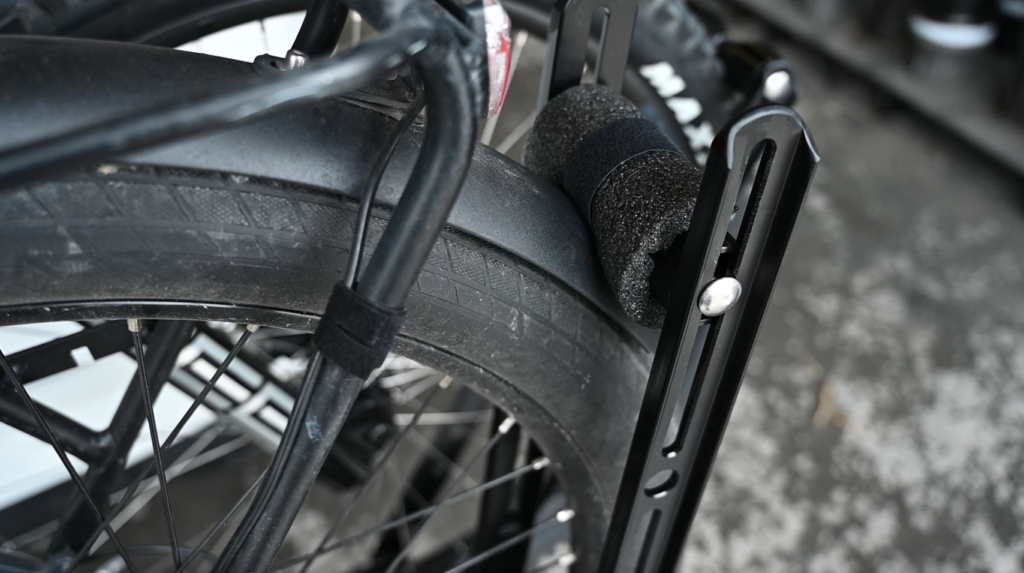
We have also seen customers place additional pipe insulation or a cut section of a pool noodle between the tire and the fender. This will help maintain the shape of the fender and prevent it from rubbing against the tire.
It is possible (and easy, remember it’s toolless) to lower the tire spool along the arm. Doing so changes the contact point on the tire and often results in it sitting lower than or tucked under the fender. Lowering the tire spool will change the angle of the arm, so be sure to check that it is still around the optimal 45 degrees.
Additionally, we recommend using the Wheel Strap accessory. A long fender prevents the tire arm from going into the optimum position to create both forward and downward force on the tire. A wheel strap will make up for the missing downward force and prevent upward movement of the rear wheel, keeping the bike securely in the tray.
Note: In the photo below that a customer sent in, the tire spool could be moved up a couple of inches to sit right below the fender.
UPDATED JANUARY 2025
One of the innovative features of the Quik Rack Mach2 is the captive safety pin at the hitch (shown with the red knob in the photo below).
The captive safety pin serves as a fail safe if the rack were to become loosened and start slipping out of the receiver. The rack will only become loose if it isn’t tightened properly with the blue lever and periodically checked.
The captive safety pin was designed because, for whatever reason, there is no standard when it comes to hitch receivers and their hitch pin holes. We cannot rely on you being able to use a standard hitch pin so the captive safety pin solves this issue for most vehicles.
The captive safety pin does NOT need to reach or sit in the hole in your receiver; it just needs to sit behind the flange (lip) of the receiver. If it does reach and sit in the hole, that’s okay, but don’t worry if it doesn’t.
The captive safety pin can be removed entirely (though we don’t recommend it) and it can easily be switched to the opposite side. This is necessary with some vehicles due to space restraints and electrical connections in the area of the receiver. Once removed, you can use a standard hitch pin bolt with cotter pin or lock.
However, it is not possible to use a standard hitch pin with the 1.25″ hitch or the 1.25″ with the 2″ adapter installed. The reason is because there is no hole going through the adapter. In other words, you can only do this with the 2″ hitch model.
Also, the hole in the hitch insert will not align with the hole in the receiver on all vehicles. Please see the dimensions FAQ to measure the location of the hole and compare it to that of the hole in your receiver.
UPDATED July 2025
Customers sometimes purchase a 1.25″ rack when they have a 2″ receiver on their vehicle. The reason for doing this is so they can use the rack with other cars, some of which may have a 1.25″ receiver. We manufacture a reducer, which is sold separately since not all customers need one or want one.
This reducer inserts into the 2″ hitch receiver, making it a 1.25″. The anti-wobble expanding pads on our rack still function perfectly when used with the reducer.
Our reducer is only for use in a 2″ hitch receiver, when using a 1.25″ rack.
Here is a video going over how to install the 1.25″ adapter.
There are 3rd party adapters on the market that can be purchased separately, however we do not recommend using one. These are generally a square tube or sleeve style. When using this type of adapter, the expanding pads on the rack are able to tighten inside the sleeve, but typically the sleeve itself does not tighten inside your hitch. This results in excessive movement in the whole system.
NOTE: We do not warranty any rack setup that uses an adapter other than the one QuikrStuff manufactures.
UPDATED MAY 2025
You may use a hitch extender with your rack. We do not currently manufacture or sell a hitch extender. You can find these at etrailer.com or from other companies.
Often times using an extension can introduce more play and noise into the whole system. You can try an anti-rattle stabilizer (shown in photo below) to alleviate these issues. Another option is welding the extender into your receiver, but this does make it a permanent feature.
Be sure to consider the number and weight of the bikes you are hauling and realize that the limits will be reduced when an extension is used. Refer to the class rating and tongue weight of your vehicle’s hitch receiver. Typically, your tongue weight will be reduced by 50% when using an extension.
1.25″ Mach2
1 bike – 120 lbs
2 bikes – 150 lbs total for both bikes
3 bikes – 120 lbs total for all three bikes
2″ Mach2
1 bike – 120 lbs
2 bikes – 240 lbs
3 bikes – 300 lbs
4 bikes – 185 lbs
NOTE: We do not warranty any rack setup that is using a hitch extender because they are not our products.
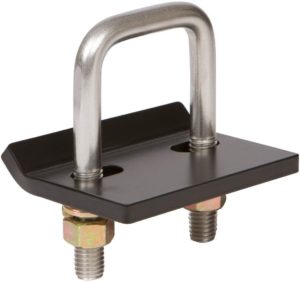
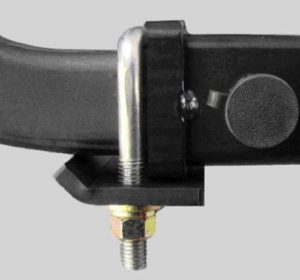
UPDATED NOVEMBER 2024
Yes! It clears by about an inch without a hitch extender. But it was only on one 2019 model, so you must check it yourself. Our dimensions FAQ might be helpful for this.
See this post by one of our testers – https://www.facebook.com/matt.brenner.75/posts/10158448921359329
UPDATED JANUARY 2025
One of the innovative features of the Quik Rack Mach2 is the captive safety pin at the hitch (shown with the red knob in the photo below).
The captive safety pin serves as a fail safe if the rack were to become loosened and start slipping out of the receiver. The rack will only become loose if it isn’t tightened properly with the blue lever and periodically checked.
The captive safety pin was designed because, for whatever reason, there is no standard when it comes to hitch receivers and their hitch pin holes. We cannot rely on you being able to use a standard hitch pin so the captive safety pin solves this issue for most vehicles.
The captive safety pin does NOT need to reach or sit in the hole in your receiver; it just needs to sit behind the flange (lip) of the receiver. If it does reach and sit in the hole, that’s okay, but don’t worry if it doesn’t.
The captive safety pin can be removed entirely (though we don’t recommend it) and it can easily be switched to the opposite side. This is necessary with some vehicles due to space restraints and electrical connections in the area of the receiver. Remove it with one screw and use your own lock or hitch pin.
Watch our demo to learn more about the adaptability of the redesigned hitch:
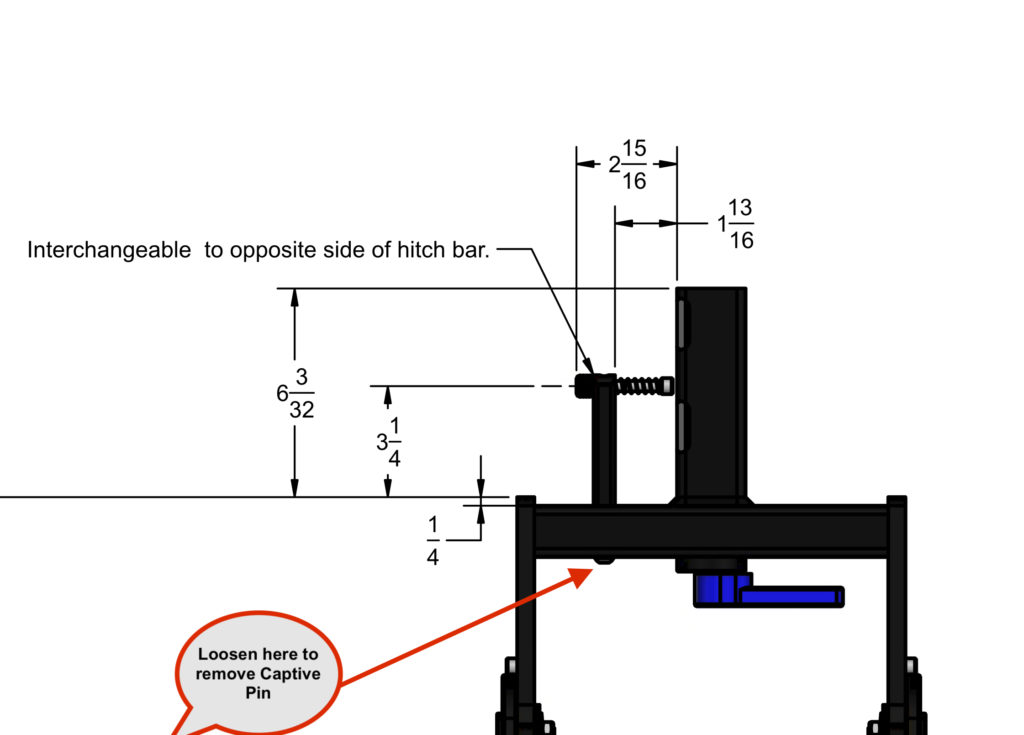
UPDATED NOVEMBER 2024
The Mach2 hitch design uses two aluminum pads instead of one steel ball, which was what was used with the inventor’s previous bike rack. This is a huge improvement! The pads are stronger, smoother, and more stable, and the old steel ball version could deform the hitch over time.
Our rack also comes with a Captive Safety Pin for additional peace of mind. The Captive Safety Pin does not go through a hole in your receiver; rather, it sits just behind the flange on your receiver. A regular locking pin can be used, if so desired. And the Captive Safety Pin can be removed with one screw for vehicles that don’t have clearance for it.
Watch it in action:
Here are the dimensions for the Hitch assembly.
UPDATED NOVEMBER 2024
The ramp weighs 10 pounds and measures 56-1/4″ long. It does not fold like the rack and Add-Ons do. See it in action:
UPDATED NOVEMBER 2024
We advise against it because it extends beyond DOT regulations and it would put excessive leverage and strain on the vehicle’s hitch and rack components.
We would not warranty this usage.
UPDATED NOVEMBER 2025
Everyone has a different vehicle model and spare tire size (as well as different bikes), but typically, no, our rack is not designed to go on a vehicle with a rear spare tire.
Using an Extender
Some customers use an extender with the 2″ version of the rack to push everything further away. This is an option if you aren’t carrying too much weight. Typically, an extender reduces the recommended weight by about 50%. Also, you will most likely not get the famous QuikrStuff no-wobble-at-the-hitch when an extender is introduced into the mix.
We do not make an extender and our warranty does not cover usage of the rack with third-party extenders, adapters, or swing-away arms. This is because we don’t know the integrity of third-party products and we haven’t tested our rack with any of them.
We are not saying that using an extender is necessarily unsafe. Plenty of customers do use one with our rack. However, it’ll be up to you to determine if your bikes are safe.
And we are not saying that we won’t support you when it comes to minor repairs and replacing parts on your rack. We just can’t be held responsible for your rack or your bikes if there is catastrophic failure due to using the rack with an extender.
Solutions
With some vehicle/tire/bike combinations, the rack will work just fine, as shown in the photo below with a 2014 Toyota FJ Cruiser. You might be able to determine this ahead of actually ordering and receiving a rack by looking at our dimensions FAQ.
Another idea is to use the rack with your spare tire and no extender. How? By removing a pedal from the bike closest to the spare, essentially putting the bike right up against the spare tire. We saw a jeep in Utah and took pictures of this idea. We can’t guarantee that it will work with your vehicle, but looking at our dimensions FAQ might help.
Customer Scott says, “I have a Jeep with an oversized tire and mine fits just fine. I just turn the cranks on my bike so the top pedal sits inside the wheel of my spare.”
And one final solution – you can leave the main rack empty and load up your bike(s) on the add-on(s). The main rack would serve as a spacer.
Note: QuikrStuff is working on a hitch that is 1.5″ longer than our current hitch. This may be ready by February 2026.
UPDATED AUGUST 2025
The QuikrStuff Mach2 bike rack was not designed to carry trikes.
We are getting more and more requests for an add-on that will fit a trike and it is on our long list of products to consider developing.
It might be possible to use one rack and two add-ons and put the rear tires in trays one and three and the front tire in tray two. But you will need to look at the rack dimensions and then measure your specific bike to see if it would fit on the rack in this way.
UPDATED NOVEMBER 2024
We recently met a doctor in our town who had an Elliptigo 11R bike and it fits fine on our rack with no modification.
If you wanted to carry two Elliptigo bikes, you would need to have one Add-on in between them because of the width of the base being larger than our width.
We may look into creating a customization to carry two Elliptigo bikes next to each other, but that will be some time off as we crank out higher demand items. 🙂
Some pics:
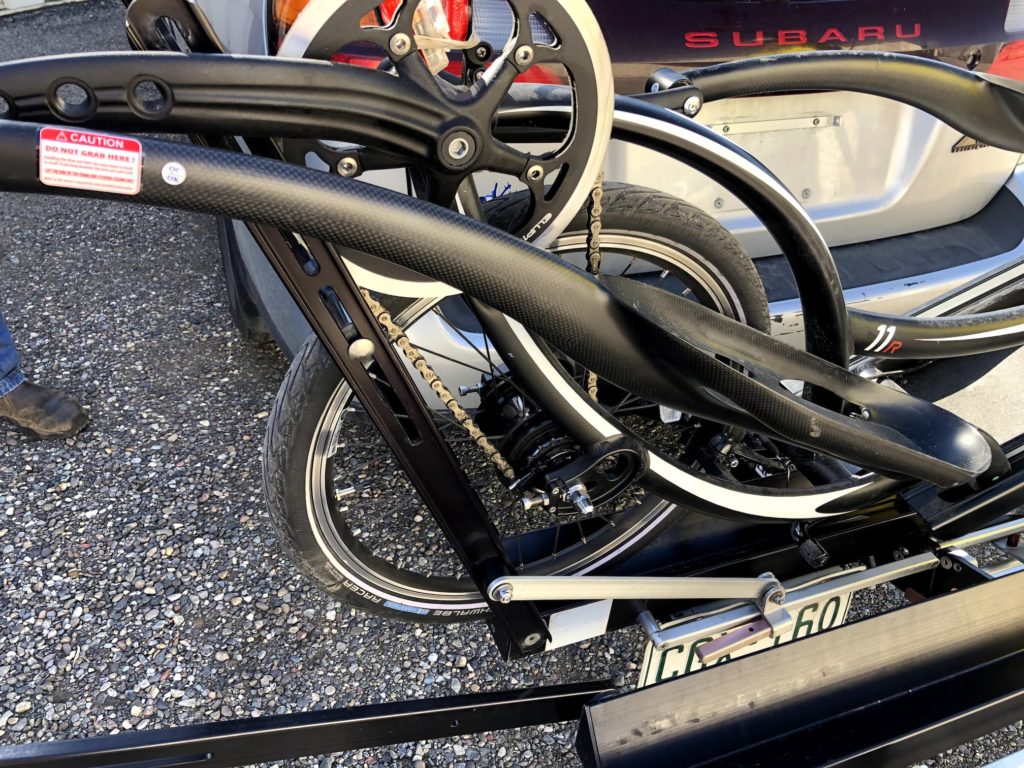
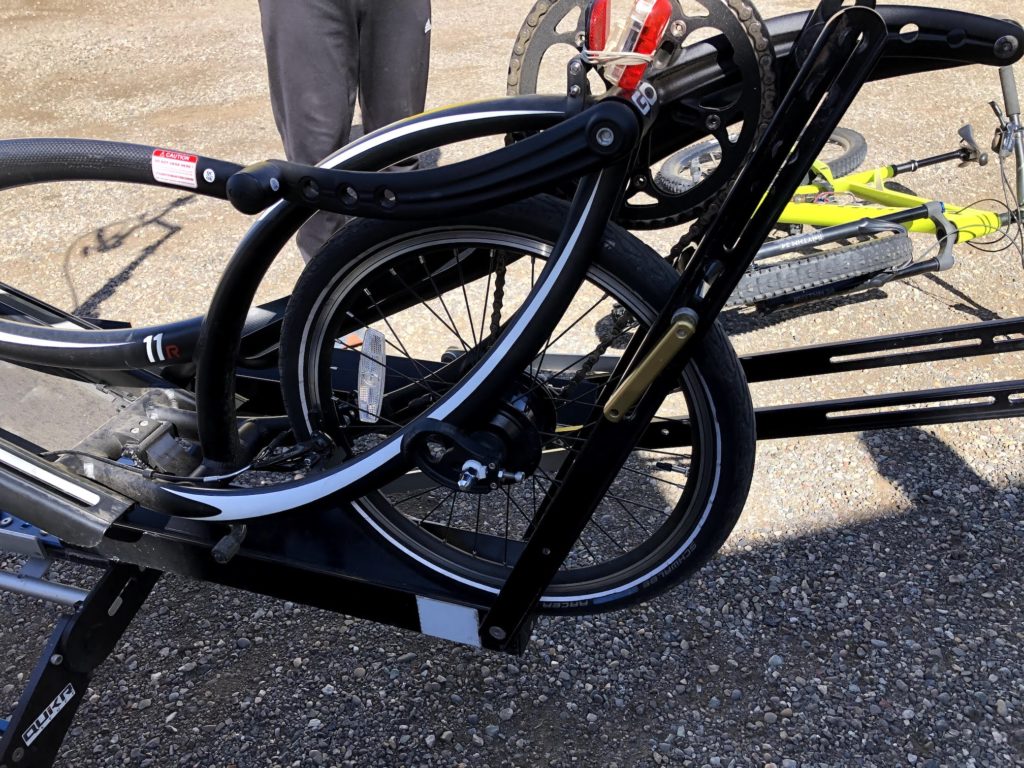
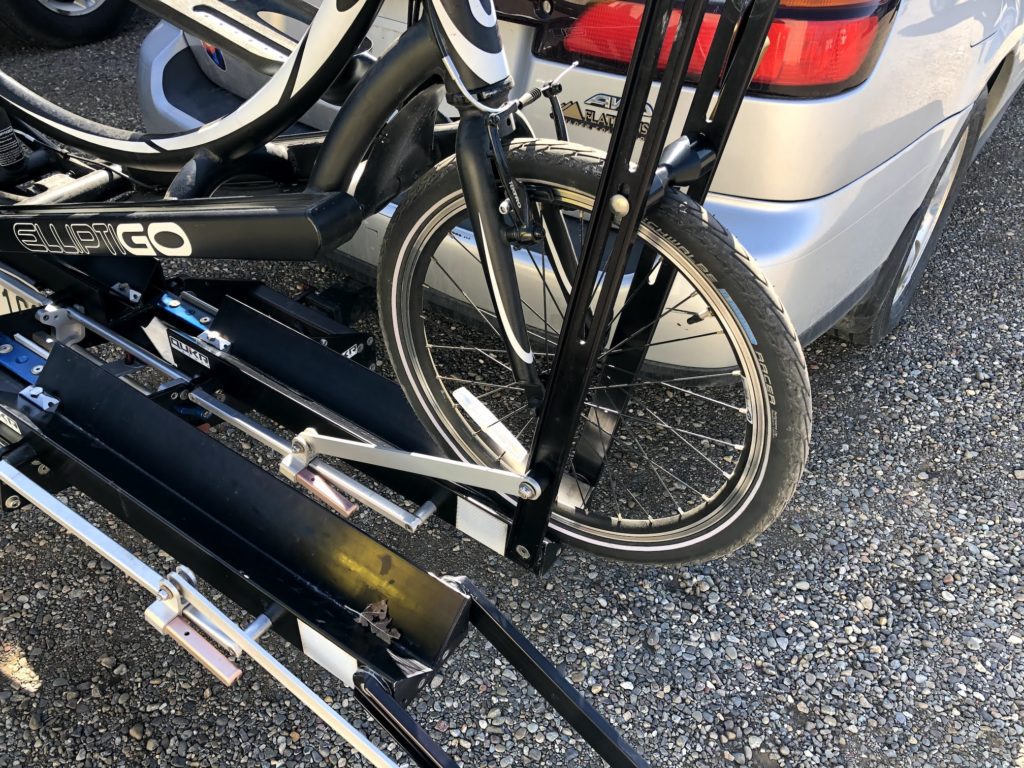
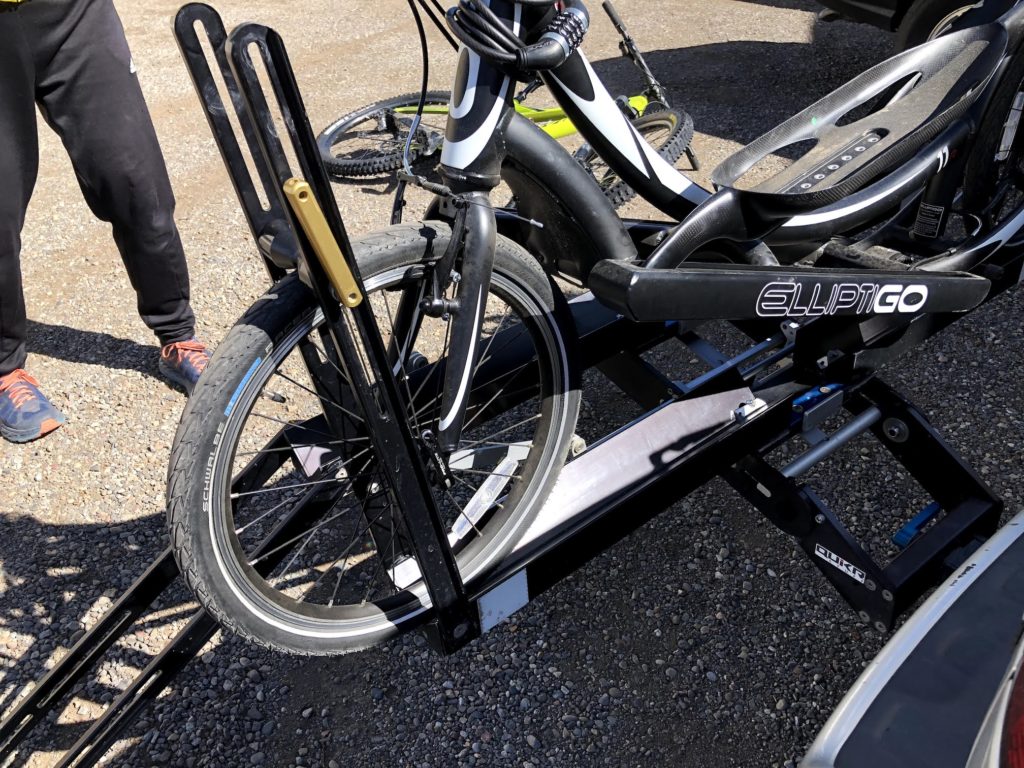
UPDATED JULY 2025
YES, the QuikrStuff Mach2 bike rack can be used on the popular Tesla Model Y. Note that we say this based on a 2023 Tesla Model Y.
Here’s what we know about the rack on a Tesla Y:
The rack fits very close to the car. If you insert the rack into the receiver just far enough to cover both expanding pads, you will still be able to get the rack into its upright position. Some Tesla owners report that this isn’t possible but that is because they are pushing the rack all the way into the receiver. You only need to push it in far enough to cover the two expanding pads. As long as both pads are covered, the rack will stay secured.
There are also rumors that a loaded bike may bump into the back of the car. This will not happen if you install the rack as suggested in the above paragraph.
You’ll need to change the Captive Safety Pin from the left side to the right side of the car. This is because there is an electrical connection in the way on the left side. Moving the Captive Safety Pin is easily done with no tools although it’s tight in there and if your hand doesn’t fit you may need to use needle nose pliers. The Captive Safety Pin does not need to go through the hole in the receiver; it does, however, need to sit behind the flange on the receiver. Remember, the Captive Safety Pin is not the primary mechanism holding the rack to your vehicle; it is the unique expanding pads in the hitch that do that job.
VIDEO –> This video shows how to move the Captive Safety Pin and install the Quik Rack Mach2 on a Tesla Model Y.
We haven’t noticed the rack interfering with the performance of the mirrors. We aren’t big fans of the tilting mirrors (when they tilt way down when you first put it into reverse) and know you can turn that feature off. The car will tell you to STOP when backing up because it thinks the rack is a separate object that you’re about to hit. You can turn on trailer mode so it realizes that something is attached.
A customer recently informed us and sent in pictures showing that he could open his hatchback with the bike rack (single, no add-on) in the vertical/stowed position. If you have an add-on installed as well, it is quick and easy to tilt it into the 45-degree position or horizontal/carrying position and then open the hatchback. Also, you can open up the backend with a bike (or two) on if you tilt the rack to its lowest position. This is possible, too, with two bikes and the ramp attached as well.
We know these things because CEO Bryan Wachs has a Tesla Model Y and always has the rack on his car. If you have any further questions, he will be happy to respond to them. Email us at support @quikrstuff.com.
Note, again, that this information is based on a 2023 model. We have heard from a few customers that the Mach2 does not work on a 2026 Model Y without an extender. Use of third party products such as extenders, adapters, swing away arms, bike covers, etc. voids the warranty on the Quik Rack Mach2.
UPDATED JANUARY 2025
When selecting and using a hitch-mount bike rack, understanding the concept of hitch class is crucial for ensuring both safety and optimal performance. This determines the compatibility of the bike rack with your vehicle, as well as the stability of your bikes during transport.
Hitch Class
Hitch class refers to the strength and size of the hitch receiver that is mounted on a vehicle. There are several hitch classes (I, II, III, IV, and V), each with different weight capacities. The class of the hitch directly influences the types of bike racks that can be used, as well as the maximum weight the vehicle can safely carry.
- Class I hitches, typically rated for 100-200 pounds tongue weight, are common on compact cars and smaller SUVs and minivans. They typically have a 1.25” receiver size and can be used with cargo carriers, kayaks, mobility scooters, and 1-2 lightweight bikes.
- Class II hitches can handle a higher capacity, usually 200-525 pounds tongue weight. These are most often found on passenger cars, smaller SUVs, and minivans and have a 1.25” receiver. They carry similar loads as a class I hitch as well as small trailers, small pop-up campers, and small boats. Class I receivers have a stopper to prevent you from carrying too much weight; class IIs do not have the stopper.
- Class III hitches, rated for 300-800 pounds tongue weight, are the most common hitch and are 2” x 2”. You’ll find them on full-size cars, large SUVs, minivans, and light trucks. They accommodate larger, more robust bike racks capable of carrying multiple bikes. You might be able to use a 1.25” accessory with an appropriate adapter.
- Class IV and V hitches are typically used on larger vehicles like full-size trucks and heavy-duty SUVs. These are designed for much heavier loads like large travel trailers, utility trailers, motorcycles, snowmobiles, and 2-4 heavy bikes.
When choosing a hitch-mount bike rack, it’s important to ensure that both the rack and the vehicle’s hitch class are compatible. For instance, a Class I hitch may not be able to handle a heavy-duty bike rack designed for Class III or IV hitches, which could lead to unsafe loading conditions or damage.
Class III or greater is required to carry four bikes and/or eBikes; class II for 1-, 2-, or 3-bike setups, these being regular bikes, not eBikes; possibly a Class I hitch for 1 or 2 very light bikes. These are generalizations and recommendations; please check your vehicle manufacturer’s tongue weight guidelines and use your best judgment based on the information you have gathered.
Please feel free to reach out to support@quikrstuff.com with any questions you may have.
UPDATED NOVEMBER 2024
There are many different vehicle/receiver combinations. Because of this, we cannot keep track of fitment on every type of vehicle and therefore do not provide fitment answers for you. Instead, we provide information you can use to measure and determine for yourself if the Quik Rack Mach2 will work with your vehicle.
A common question when thinking about the depth of a receiver and the style of our hitch insert with its expanding pads is how far into the receiver the hitch absolutely has to go. Ideally, the rack should be inserted into a receiver as far as it can go; however, there are recessed receivers, short receivers, and/or bumpers that can complicate the matter. This diagram shows how far the hitch insert has to go into the receiver in order for the silver pads to be covered.
At minimum insertion, there will be 1 5/16″ outside of the receiver to the point of the cross bar on the hitch. See diagram.
An issue that arises is whether, with minimum insertion, the rack will clear the bumper of a vehicle. You must determine that for yourself based on this information as well as other measurements in the dimensions FAQ.
If the hitch insert is too short for your vehicle, you might think, “Oh, I’ll just use an extender.” We do not currently make or sell an extender and we cannot warranty the rack when a third party product is used. Also, you need to be wary of pushing the rack and all the weight it will bear too far away from the vehicle. Doing so will reduce the amount of weight the rack can safely carry. And, as mentioned, we cannot cover under warranty any damage incurred when an extender is used.
Be aware of the tongue weight of your vehicle.
After measuring, if you still have questions, please reach out to us at support@quikrstuff.com.
Specs and Fitment Questions
UPDATED DECEMBER 2024
We cannot guarantee fitment of the rack on your vehicle because there are too many changes in variables in model spec, OEM (original equipment manufacturer), and aftermarket hitches and adapters, as well as way too many vehicles to keep up a database. Instead, we provide for you here the information you need to measure and make a determination yourself. If you can’t find the answer you need, contact us!
To determine if the Mach2 will hold your specific bikes, see this FAQ. If you’re not sure, we can usually give you a definitive yes or no, especially if you send in a photo of your bike(s).
The diagrams below use ordinate dimensions. They show the distance from a base point (labeled 0 in the drawings) to multiple reference points. Look for measurements extending horizontally left or right from the zero OR extending vertically up or down from the zero. The base point for this measurement is taken from the minimum insertion point of the rack.
PRINTABLE PDF – MACH-2-CUST-2D–REV-B–FOR-WEB
PRINTABLE PDF – MACH-2-CUST-2D–REV-B–FOR-WEB
UPDATED January 2025
The load capacities provided here are conservative numbers made to protect your investment in your bikes. Please check the Hitch Class Rating for your vehicle/hitch as OEM (original equipment manufacturer) will not be the same as an aftermarket hitch. Read this FAQ for more information about hitch safety.
These numbers do not apply when hitch adapters, extenders, swing away arms, or bike covers are used. All of these items put more leverage (stress) on the hitch/crossbar and therefore lower the weight capacities of the rack. Also, use of any of these items will void the warranty.
1.25″ V2 – Mach2
1 bike – 120 lbs
2 bikes – 150 lbs total for both bikes
3 bikes – 120 lbs total for all three bikes
2″ Mach2
1 bike – 120 lbs
2 bikes – 240 lbs total for both bikes
3 bikes – 300 lbs total for all three bikes
4 bikes – 185 lbs total for all four bikes
Even though the 1.25″ rack can hold 150 pounds total and the 2″ rack can carry 300 pounds total, each individual bike rack tray has a weight limit of 120 pounds that cannot be exceeded. Doing so could cause the rack to fail.
The maximum weight for each tray is reduced as the trays get further from the vehicle. That is why trays one and two can hold 120 pounds, but trays three and four cannot. Think about a diving board. As you get further out on the diving board you bend the board more by increasing the force on the end of the board. You also increase the force on the diving board’s attachments to the ground even though you weigh the same. As you add more bikes to the rack with add-ons, you increase the force on the rack frame, especially the attachment point to the car.
Therefore, we highly recommend that you adhere to the weight capacity guidelines listed here, not only for the safety of your bikes but also for the safety of others who are on the road near you. Carrying more weight than is suggested will void the warranty on the product.
UPDATED NOVEMBER 2024
The base Mach2 hitch rack mount weighs approximately 30.7 pounds and each Add-on weighs 22.7 pounds. The ramp weighs 10 pounds.
UPDATED JANUARY 2025
The Quik Rack Mach2 bike rack can be used with almost all bikes that weigh 120 pounds or less. More specifically, it handles a wheelbase of 56″ with wheel sizes from 12″ to 29″, and anywhere from skinny road bike tires up to a 5″ wide tire with no adapters needed.
The rack is not designed to carry trikes.
See the no-tools tire size adjustment in action:
Here is an image of the bike size range dimensions.
UPDATED NOVEMBER 2024
10.04 inches is the distance between one tray groove and the next. See full dimensions below and also visit our dimensions FAQ.
Printable Mach2 CAD drawing from the top – PDF
UPDATED NOVEMBER 2024
The rack can accommodate skinny road bike tires all the way through tires as wide as 5” with no adapters needed. The distance is 4.77″ between the arms, but dare we say, tires are not really accurate in their dimensions?
The Mach2 fits the Vee Snow Shoe 2XL, which is 5.05″ wide. (stated by the manufacturer)
UPDATED APRIL 2025

We have also seen customers place additional pipe insulation or a cut section of a pool noodle between the tire and the fender. This will help maintain the shape of the fender and prevent it from rubbing against the tire.
It is possible (and easy, remember it’s toolless) to lower the tire spool along the arm. Doing so changes the contact point on the tire and often results in it sitting lower than or tucked under the fender. Lowering the tire spool will change the angle of the arm, so be sure to check that it is still around the optimal 45 degrees.
Additionally, we recommend using the Wheel Strap accessory. A long fender prevents the tire arm from going into the optimum position to create both forward and downward force on the tire. A wheel strap will make up for the missing downward force and prevent upward movement of the rear wheel, keeping the bike securely in the tray.
Note: In the photo below that a customer sent in, the tire spool could be moved up a couple of inches to sit right below the fender.
UPDATED JANUARY 2025
One of the innovative features of the Quik Rack Mach2 is the captive safety pin at the hitch (shown with the red knob in the photo below).
The captive safety pin serves as a fail safe if the rack were to become loosened and start slipping out of the receiver. The rack will only become loose if it isn’t tightened properly with the blue lever and periodically checked.
The captive safety pin was designed because, for whatever reason, there is no standard when it comes to hitch receivers and their hitch pin holes. We cannot rely on you being able to use a standard hitch pin so the captive safety pin solves this issue for most vehicles.
The captive safety pin does NOT need to reach or sit in the hole in your receiver; it just needs to sit behind the flange (lip) of the receiver. If it does reach and sit in the hole, that’s okay, but don’t worry if it doesn’t.
The captive safety pin can be removed entirely (though we don’t recommend it) and it can easily be switched to the opposite side. This is necessary with some vehicles due to space restraints and electrical connections in the area of the receiver. Once removed, you can use a standard hitch pin bolt with cotter pin or lock.
However, it is not possible to use a standard hitch pin with the 1.25″ hitch or the 1.25″ with the 2″ adapter installed. The reason is because there is no hole going through the adapter. In other words, you can only do this with the 2″ hitch model.
Also, the hole in the hitch insert will not align with the hole in the receiver on all vehicles. Please see the dimensions FAQ to measure the location of the hole and compare it to that of the hole in your receiver.
UPDATED July 2025
Customers sometimes purchase a 1.25″ rack when they have a 2″ receiver on their vehicle. The reason for doing this is so they can use the rack with other cars, some of which may have a 1.25″ receiver. We manufacture a reducer, which is sold separately since not all customers need one or want one.
This reducer inserts into the 2″ hitch receiver, making it a 1.25″. The anti-wobble expanding pads on our rack still function perfectly when used with the reducer.
Our reducer is only for use in a 2″ hitch receiver, when using a 1.25″ rack.
Here is a video going over how to install the 1.25″ adapter.
There are 3rd party adapters on the market that can be purchased separately, however we do not recommend using one. These are generally a square tube or sleeve style. When using this type of adapter, the expanding pads on the rack are able to tighten inside the sleeve, but typically the sleeve itself does not tighten inside your hitch. This results in excessive movement in the whole system.
NOTE: We do not warranty any rack setup that uses an adapter other than the one QuikrStuff manufactures.
UPDATED MAY 2025
You may use a hitch extender with your rack. We do not currently manufacture or sell a hitch extender. You can find these at etrailer.com or from other companies.
Often times using an extension can introduce more play and noise into the whole system. You can try an anti-rattle stabilizer (shown in photo below) to alleviate these issues. Another option is welding the extender into your receiver, but this does make it a permanent feature.
Be sure to consider the number and weight of the bikes you are hauling and realize that the limits will be reduced when an extension is used. Refer to the class rating and tongue weight of your vehicle’s hitch receiver. Typically, your tongue weight will be reduced by 50% when using an extension.
1.25″ Mach2
1 bike – 120 lbs
2 bikes – 150 lbs total for both bikes
3 bikes – 120 lbs total for all three bikes
2″ Mach2
1 bike – 120 lbs
2 bikes – 240 lbs
3 bikes – 300 lbs
4 bikes – 185 lbs
NOTE: We do not warranty any rack setup that is using a hitch extender because they are not our products.


UPDATED NOVEMBER 2024
Yes! It clears by about an inch without a hitch extender. But it was only on one 2019 model, so you must check it yourself. Our dimensions FAQ might be helpful for this.
See this post by one of our testers – https://www.facebook.com/matt.brenner.75/posts/10158448921359329
UPDATED JANUARY 2025
One of the innovative features of the Quik Rack Mach2 is the captive safety pin at the hitch (shown with the red knob in the photo below).
The captive safety pin serves as a fail safe if the rack were to become loosened and start slipping out of the receiver. The rack will only become loose if it isn’t tightened properly with the blue lever and periodically checked.
The captive safety pin was designed because, for whatever reason, there is no standard when it comes to hitch receivers and their hitch pin holes. We cannot rely on you being able to use a standard hitch pin so the captive safety pin solves this issue for most vehicles.
The captive safety pin does NOT need to reach or sit in the hole in your receiver; it just needs to sit behind the flange (lip) of the receiver. If it does reach and sit in the hole, that’s okay, but don’t worry if it doesn’t.
The captive safety pin can be removed entirely (though we don’t recommend it) and it can easily be switched to the opposite side. This is necessary with some vehicles due to space restraints and electrical connections in the area of the receiver. Remove it with one screw and use your own lock or hitch pin.
Watch our demo to learn more about the adaptability of the redesigned hitch:

UPDATED NOVEMBER 2024
The Mach2 hitch design uses two aluminum pads instead of one steel ball, which was what was used with the inventor’s previous bike rack. This is a huge improvement! The pads are stronger, smoother, and more stable, and the old steel ball version could deform the hitch over time.
Our rack also comes with a Captive Safety Pin for additional peace of mind. The Captive Safety Pin does not go through a hole in your receiver; rather, it sits just behind the flange on your receiver. A regular locking pin can be used, if so desired. And the Captive Safety Pin can be removed with one screw for vehicles that don’t have clearance for it.
Watch it in action:
Here are the dimensions for the Hitch assembly.
UPDATED NOVEMBER 2024
The ramp weighs 10 pounds and measures 56-1/4″ long. It does not fold like the rack and Add-Ons do. See it in action:
UPDATED NOVEMBER 2024
We advise against it because it extends beyond DOT regulations and it would put excessive leverage and strain on the vehicle’s hitch and rack components.
We would not warranty this usage.
UPDATED NOVEMBER 2025
Everyone has a different vehicle model and spare tire size (as well as different bikes), but typically, no, our rack is not designed to go on a vehicle with a rear spare tire.
Using an Extender
Some customers use an extender with the 2″ version of the rack to push everything further away. This is an option if you aren’t carrying too much weight. Typically, an extender reduces the recommended weight by about 50%. Also, you will most likely not get the famous QuikrStuff no-wobble-at-the-hitch when an extender is introduced into the mix.
We do not make an extender and our warranty does not cover usage of the rack with third-party extenders, adapters, or swing-away arms. This is because we don’t know the integrity of third-party products and we haven’t tested our rack with any of them.
We are not saying that using an extender is necessarily unsafe. Plenty of customers do use one with our rack. However, it’ll be up to you to determine if your bikes are safe.
And we are not saying that we won’t support you when it comes to minor repairs and replacing parts on your rack. We just can’t be held responsible for your rack or your bikes if there is catastrophic failure due to using the rack with an extender.
Solutions
With some vehicle/tire/bike combinations, the rack will work just fine, as shown in the photo below with a 2014 Toyota FJ Cruiser. You might be able to determine this ahead of actually ordering and receiving a rack by looking at our dimensions FAQ.
Another idea is to use the rack with your spare tire and no extender. How? By removing a pedal from the bike closest to the spare, essentially putting the bike right up against the spare tire. We saw a jeep in Utah and took pictures of this idea. We can’t guarantee that it will work with your vehicle, but looking at our dimensions FAQ might help.
Customer Scott says, “I have a Jeep with an oversized tire and mine fits just fine. I just turn the cranks on my bike so the top pedal sits inside the wheel of my spare.”
And one final solution – you can leave the main rack empty and load up your bike(s) on the add-on(s). The main rack would serve as a spacer.
Note: QuikrStuff is working on a hitch that is 1.5″ longer than our current hitch. This may be ready by February 2026.
UPDATED AUGUST 2025
The QuikrStuff Mach2 bike rack was not designed to carry trikes.
We are getting more and more requests for an add-on that will fit a trike and it is on our long list of products to consider developing.
It might be possible to use one rack and two add-ons and put the rear tires in trays one and three and the front tire in tray two. But you will need to look at the rack dimensions and then measure your specific bike to see if it would fit on the rack in this way.
UPDATED NOVEMBER 2024
We recently met a doctor in our town who had an Elliptigo 11R bike and it fits fine on our rack with no modification.
If you wanted to carry two Elliptigo bikes, you would need to have one Add-on in between them because of the width of the base being larger than our width.
We may look into creating a customization to carry two Elliptigo bikes next to each other, but that will be some time off as we crank out higher demand items. 🙂
Some pics:




UPDATED JULY 2025
YES, the QuikrStuff Mach2 bike rack can be used on the popular Tesla Model Y. Note that we say this based on a 2023 Tesla Model Y.
Here’s what we know about the rack on a Tesla Y:
The rack fits very close to the car. If you insert the rack into the receiver just far enough to cover both expanding pads, you will still be able to get the rack into its upright position. Some Tesla owners report that this isn’t possible but that is because they are pushing the rack all the way into the receiver. You only need to push it in far enough to cover the two expanding pads. As long as both pads are covered, the rack will stay secured.
There are also rumors that a loaded bike may bump into the back of the car. This will not happen if you install the rack as suggested in the above paragraph.
You’ll need to change the Captive Safety Pin from the left side to the right side of the car. This is because there is an electrical connection in the way on the left side. Moving the Captive Safety Pin is easily done with no tools although it’s tight in there and if your hand doesn’t fit you may need to use needle nose pliers. The Captive Safety Pin does not need to go through the hole in the receiver; it does, however, need to sit behind the flange on the receiver. Remember, the Captive Safety Pin is not the primary mechanism holding the rack to your vehicle; it is the unique expanding pads in the hitch that do that job.
VIDEO –> This video shows how to move the Captive Safety Pin and install the Quik Rack Mach2 on a Tesla Model Y.
We haven’t noticed the rack interfering with the performance of the mirrors. We aren’t big fans of the tilting mirrors (when they tilt way down when you first put it into reverse) and know you can turn that feature off. The car will tell you to STOP when backing up because it thinks the rack is a separate object that you’re about to hit. You can turn on trailer mode so it realizes that something is attached.
A customer recently informed us and sent in pictures showing that he could open his hatchback with the bike rack (single, no add-on) in the vertical/stowed position. If you have an add-on installed as well, it is quick and easy to tilt it into the 45-degree position or horizontal/carrying position and then open the hatchback. Also, you can open up the backend with a bike (or two) on if you tilt the rack to its lowest position. This is possible, too, with two bikes and the ramp attached as well.
We know these things because CEO Bryan Wachs has a Tesla Model Y and always has the rack on his car. If you have any further questions, he will be happy to respond to them. Email us at support @quikrstuff.com.
Note, again, that this information is based on a 2023 model. We have heard from a few customers that the Mach2 does not work on a 2026 Model Y without an extender. Use of third party products such as extenders, adapters, swing away arms, bike covers, etc. voids the warranty on the Quik Rack Mach2.
UPDATED JANUARY 2025
When selecting and using a hitch-mount bike rack, understanding the concept of hitch class is crucial for ensuring both safety and optimal performance. This determines the compatibility of the bike rack with your vehicle, as well as the stability of your bikes during transport.
Hitch Class
Hitch class refers to the strength and size of the hitch receiver that is mounted on a vehicle. There are several hitch classes (I, II, III, IV, and V), each with different weight capacities. The class of the hitch directly influences the types of bike racks that can be used, as well as the maximum weight the vehicle can safely carry.
- Class I hitches, typically rated for 100-200 pounds tongue weight, are common on compact cars and smaller SUVs and minivans. They typically have a 1.25” receiver size and can be used with cargo carriers, kayaks, mobility scooters, and 1-2 lightweight bikes.
- Class II hitches can handle a higher capacity, usually 200-525 pounds tongue weight. These are most often found on passenger cars, smaller SUVs, and minivans and have a 1.25” receiver. They carry similar loads as a class I hitch as well as small trailers, small pop-up campers, and small boats. Class I receivers have a stopper to prevent you from carrying too much weight; class IIs do not have the stopper.
- Class III hitches, rated for 300-800 pounds tongue weight, are the most common hitch and are 2” x 2”. You’ll find them on full-size cars, large SUVs, minivans, and light trucks. They accommodate larger, more robust bike racks capable of carrying multiple bikes. You might be able to use a 1.25” accessory with an appropriate adapter.
- Class IV and V hitches are typically used on larger vehicles like full-size trucks and heavy-duty SUVs. These are designed for much heavier loads like large travel trailers, utility trailers, motorcycles, snowmobiles, and 2-4 heavy bikes.
When choosing a hitch-mount bike rack, it’s important to ensure that both the rack and the vehicle’s hitch class are compatible. For instance, a Class I hitch may not be able to handle a heavy-duty bike rack designed for Class III or IV hitches, which could lead to unsafe loading conditions or damage.
Class III or greater is required to carry four bikes and/or eBikes; class II for 1-, 2-, or 3-bike setups, these being regular bikes, not eBikes; possibly a Class I hitch for 1 or 2 very light bikes. These are generalizations and recommendations; please check your vehicle manufacturer’s tongue weight guidelines and use your best judgment based on the information you have gathered.
Please feel free to reach out to support@quikrstuff.com with any questions you may have.
UPDATED NOVEMBER 2024
There are many different vehicle/receiver combinations. Because of this, we cannot keep track of fitment on every type of vehicle and therefore do not provide fitment answers for you. Instead, we provide information you can use to measure and determine for yourself if the Quik Rack Mach2 will work with your vehicle.
A common question when thinking about the depth of a receiver and the style of our hitch insert with its expanding pads is how far into the receiver the hitch absolutely has to go. Ideally, the rack should be inserted into a receiver as far as it can go; however, there are recessed receivers, short receivers, and/or bumpers that can complicate the matter. This diagram shows how far the hitch insert has to go into the receiver in order for the silver pads to be covered.
At minimum insertion, there will be 1 5/16″ outside of the receiver to the point of the cross bar on the hitch. See diagram.
An issue that arises is whether, with minimum insertion, the rack will clear the bumper of a vehicle. You must determine that for yourself based on this information as well as other measurements in the dimensions FAQ.
If the hitch insert is too short for your vehicle, you might think, “Oh, I’ll just use an extender.” We do not currently make or sell an extender and we cannot warranty the rack when a third party product is used. Also, you need to be wary of pushing the rack and all the weight it will bear too far away from the vehicle. Doing so will reduce the amount of weight the rack can safely carry. And, as mentioned, we cannot cover under warranty any damage incurred when an extender is used.
Be aware of the tongue weight of your vehicle.
After measuring, if you still have questions, please reach out to us at support@quikrstuff.com.
Features
UPDATED DECEMBER 2024
We cannot guarantee fitment of the rack on your vehicle because there are too many changes in variables in model spec, OEM (original equipment manufacturer), and aftermarket hitches and adapters, as well as way too many vehicles to keep up a database. Instead, we provide for you here the information you need to measure and make a determination yourself. If you can’t find the answer you need, contact us!
To determine if the Mach2 will hold your specific bikes, see this FAQ. If you’re not sure, we can usually give you a definitive yes or no, especially if you send in a photo of your bike(s).
The diagrams below use ordinate dimensions. They show the distance from a base point (labeled 0 in the drawings) to multiple reference points. Look for measurements extending horizontally left or right from the zero OR extending vertically up or down from the zero. The base point for this measurement is taken from the minimum insertion point of the rack.
PRINTABLE PDF – MACH-2-CUST-2D–REV-B–FOR-WEB
PRINTABLE PDF – MACH-2-CUST-2D–REV-B–FOR-WEB
UPDATED January 2025
The load capacities provided here are conservative numbers made to protect your investment in your bikes. Please check the Hitch Class Rating for your vehicle/hitch as OEM (original equipment manufacturer) will not be the same as an aftermarket hitch. Read this FAQ for more information about hitch safety.
These numbers do not apply when hitch adapters, extenders, swing away arms, or bike covers are used. All of these items put more leverage (stress) on the hitch/crossbar and therefore lower the weight capacities of the rack. Also, use of any of these items will void the warranty.
1.25″ V2 – Mach2
1 bike – 120 lbs
2 bikes – 150 lbs total for both bikes
3 bikes – 120 lbs total for all three bikes
2″ Mach2
1 bike – 120 lbs
2 bikes – 240 lbs total for both bikes
3 bikes – 300 lbs total for all three bikes
4 bikes – 185 lbs total for all four bikes
Even though the 1.25″ rack can hold 150 pounds total and the 2″ rack can carry 300 pounds total, each individual bike rack tray has a weight limit of 120 pounds that cannot be exceeded. Doing so could cause the rack to fail.
The maximum weight for each tray is reduced as the trays get further from the vehicle. That is why trays one and two can hold 120 pounds, but trays three and four cannot. Think about a diving board. As you get further out on the diving board you bend the board more by increasing the force on the end of the board. You also increase the force on the diving board’s attachments to the ground even though you weigh the same. As you add more bikes to the rack with add-ons, you increase the force on the rack frame, especially the attachment point to the car.
Therefore, we highly recommend that you adhere to the weight capacity guidelines listed here, not only for the safety of your bikes but also for the safety of others who are on the road near you. Carrying more weight than is suggested will void the warranty on the product.
UPDATED NOVEMBER 2024
The base Mach2 hitch rack mount weighs approximately 30.7 pounds and each Add-on weighs 22.7 pounds. The ramp weighs 10 pounds.
UPDATED JANUARY 2025
The Quik Rack Mach2 bike rack can be used with almost all bikes that weigh 120 pounds or less. More specifically, it handles a wheelbase of 56″ with wheel sizes from 12″ to 29″, and anywhere from skinny road bike tires up to a 5″ wide tire with no adapters needed.
The rack is not designed to carry trikes.
See the no-tools tire size adjustment in action:
Here is an image of the bike size range dimensions.
UPDATED NOVEMBER 2024
10.04 inches is the distance between one tray groove and the next. See full dimensions below and also visit our dimensions FAQ.
Printable Mach2 CAD drawing from the top – PDF
UPDATED NOVEMBER 2024
The rack can accommodate skinny road bike tires all the way through tires as wide as 5” with no adapters needed. The distance is 4.77″ between the arms, but dare we say, tires are not really accurate in their dimensions?
The Mach2 fits the Vee Snow Shoe 2XL, which is 5.05″ wide. (stated by the manufacturer)
UPDATED APRIL 2025

We have also seen customers place additional pipe insulation or a cut section of a pool noodle between the tire and the fender. This will help maintain the shape of the fender and prevent it from rubbing against the tire.
It is possible (and easy, remember it’s toolless) to lower the tire spool along the arm. Doing so changes the contact point on the tire and often results in it sitting lower than or tucked under the fender. Lowering the tire spool will change the angle of the arm, so be sure to check that it is still around the optimal 45 degrees.
Additionally, we recommend using the Wheel Strap accessory. A long fender prevents the tire arm from going into the optimum position to create both forward and downward force on the tire. A wheel strap will make up for the missing downward force and prevent upward movement of the rear wheel, keeping the bike securely in the tray.
Note: In the photo below that a customer sent in, the tire spool could be moved up a couple of inches to sit right below the fender.
UPDATED JANUARY 2025
One of the innovative features of the Quik Rack Mach2 is the captive safety pin at the hitch (shown with the red knob in the photo below).
The captive safety pin serves as a fail safe if the rack were to become loosened and start slipping out of the receiver. The rack will only become loose if it isn’t tightened properly with the blue lever and periodically checked.
The captive safety pin was designed because, for whatever reason, there is no standard when it comes to hitch receivers and their hitch pin holes. We cannot rely on you being able to use a standard hitch pin so the captive safety pin solves this issue for most vehicles.
The captive safety pin does NOT need to reach or sit in the hole in your receiver; it just needs to sit behind the flange (lip) of the receiver. If it does reach and sit in the hole, that’s okay, but don’t worry if it doesn’t.
The captive safety pin can be removed entirely (though we don’t recommend it) and it can easily be switched to the opposite side. This is necessary with some vehicles due to space restraints and electrical connections in the area of the receiver. Once removed, you can use a standard hitch pin bolt with cotter pin or lock.
However, it is not possible to use a standard hitch pin with the 1.25″ hitch or the 1.25″ with the 2″ adapter installed. The reason is because there is no hole going through the adapter. In other words, you can only do this with the 2″ hitch model.
Also, the hole in the hitch insert will not align with the hole in the receiver on all vehicles. Please see the dimensions FAQ to measure the location of the hole and compare it to that of the hole in your receiver.
UPDATED July 2025
Customers sometimes purchase a 1.25″ rack when they have a 2″ receiver on their vehicle. The reason for doing this is so they can use the rack with other cars, some of which may have a 1.25″ receiver. We manufacture a reducer, which is sold separately since not all customers need one or want one.
This reducer inserts into the 2″ hitch receiver, making it a 1.25″. The anti-wobble expanding pads on our rack still function perfectly when used with the reducer.
Our reducer is only for use in a 2″ hitch receiver, when using a 1.25″ rack.
Here is a video going over how to install the 1.25″ adapter.
There are 3rd party adapters on the market that can be purchased separately, however we do not recommend using one. These are generally a square tube or sleeve style. When using this type of adapter, the expanding pads on the rack are able to tighten inside the sleeve, but typically the sleeve itself does not tighten inside your hitch. This results in excessive movement in the whole system.
NOTE: We do not warranty any rack setup that uses an adapter other than the one QuikrStuff manufactures.
UPDATED MAY 2025
You may use a hitch extender with your rack. We do not currently manufacture or sell a hitch extender. You can find these at etrailer.com or from other companies.
Often times using an extension can introduce more play and noise into the whole system. You can try an anti-rattle stabilizer (shown in photo below) to alleviate these issues. Another option is welding the extender into your receiver, but this does make it a permanent feature.
Be sure to consider the number and weight of the bikes you are hauling and realize that the limits will be reduced when an extension is used. Refer to the class rating and tongue weight of your vehicle’s hitch receiver. Typically, your tongue weight will be reduced by 50% when using an extension.
1.25″ Mach2
1 bike – 120 lbs
2 bikes – 150 lbs total for both bikes
3 bikes – 120 lbs total for all three bikes
2″ Mach2
1 bike – 120 lbs
2 bikes – 240 lbs
3 bikes – 300 lbs
4 bikes – 185 lbs
NOTE: We do not warranty any rack setup that is using a hitch extender because they are not our products.


UPDATED NOVEMBER 2024
Yes! It clears by about an inch without a hitch extender. But it was only on one 2019 model, so you must check it yourself. Our dimensions FAQ might be helpful for this.
See this post by one of our testers – https://www.facebook.com/matt.brenner.75/posts/10158448921359329
UPDATED JANUARY 2025
One of the innovative features of the Quik Rack Mach2 is the captive safety pin at the hitch (shown with the red knob in the photo below).
The captive safety pin serves as a fail safe if the rack were to become loosened and start slipping out of the receiver. The rack will only become loose if it isn’t tightened properly with the blue lever and periodically checked.
The captive safety pin was designed because, for whatever reason, there is no standard when it comes to hitch receivers and their hitch pin holes. We cannot rely on you being able to use a standard hitch pin so the captive safety pin solves this issue for most vehicles.
The captive safety pin does NOT need to reach or sit in the hole in your receiver; it just needs to sit behind the flange (lip) of the receiver. If it does reach and sit in the hole, that’s okay, but don’t worry if it doesn’t.
The captive safety pin can be removed entirely (though we don’t recommend it) and it can easily be switched to the opposite side. This is necessary with some vehicles due to space restraints and electrical connections in the area of the receiver. Remove it with one screw and use your own lock or hitch pin.
Watch our demo to learn more about the adaptability of the redesigned hitch:

UPDATED NOVEMBER 2024
The Mach2 hitch design uses two aluminum pads instead of one steel ball, which was what was used with the inventor’s previous bike rack. This is a huge improvement! The pads are stronger, smoother, and more stable, and the old steel ball version could deform the hitch over time.
Our rack also comes with a Captive Safety Pin for additional peace of mind. The Captive Safety Pin does not go through a hole in your receiver; rather, it sits just behind the flange on your receiver. A regular locking pin can be used, if so desired. And the Captive Safety Pin can be removed with one screw for vehicles that don’t have clearance for it.
Watch it in action:
Here are the dimensions for the Hitch assembly.
UPDATED NOVEMBER 2024
The ramp weighs 10 pounds and measures 56-1/4″ long. It does not fold like the rack and Add-Ons do. See it in action:
UPDATED NOVEMBER 2024
We advise against it because it extends beyond DOT regulations and it would put excessive leverage and strain on the vehicle’s hitch and rack components.
We would not warranty this usage.
UPDATED NOVEMBER 2025
Everyone has a different vehicle model and spare tire size (as well as different bikes), but typically, no, our rack is not designed to go on a vehicle with a rear spare tire.
Using an Extender
Some customers use an extender with the 2″ version of the rack to push everything further away. This is an option if you aren’t carrying too much weight. Typically, an extender reduces the recommended weight by about 50%. Also, you will most likely not get the famous QuikrStuff no-wobble-at-the-hitch when an extender is introduced into the mix.
We do not make an extender and our warranty does not cover usage of the rack with third-party extenders, adapters, or swing-away arms. This is because we don’t know the integrity of third-party products and we haven’t tested our rack with any of them.
We are not saying that using an extender is necessarily unsafe. Plenty of customers do use one with our rack. However, it’ll be up to you to determine if your bikes are safe.
And we are not saying that we won’t support you when it comes to minor repairs and replacing parts on your rack. We just can’t be held responsible for your rack or your bikes if there is catastrophic failure due to using the rack with an extender.
Solutions
With some vehicle/tire/bike combinations, the rack will work just fine, as shown in the photo below with a 2014 Toyota FJ Cruiser. You might be able to determine this ahead of actually ordering and receiving a rack by looking at our dimensions FAQ.
Another idea is to use the rack with your spare tire and no extender. How? By removing a pedal from the bike closest to the spare, essentially putting the bike right up against the spare tire. We saw a jeep in Utah and took pictures of this idea. We can’t guarantee that it will work with your vehicle, but looking at our dimensions FAQ might help.
Customer Scott says, “I have a Jeep with an oversized tire and mine fits just fine. I just turn the cranks on my bike so the top pedal sits inside the wheel of my spare.”
And one final solution – you can leave the main rack empty and load up your bike(s) on the add-on(s). The main rack would serve as a spacer.
Note: QuikrStuff is working on a hitch that is 1.5″ longer than our current hitch. This may be ready by February 2026.
UPDATED AUGUST 2025
The QuikrStuff Mach2 bike rack was not designed to carry trikes.
We are getting more and more requests for an add-on that will fit a trike and it is on our long list of products to consider developing.
It might be possible to use one rack and two add-ons and put the rear tires in trays one and three and the front tire in tray two. But you will need to look at the rack dimensions and then measure your specific bike to see if it would fit on the rack in this way.
UPDATED NOVEMBER 2024
We recently met a doctor in our town who had an Elliptigo 11R bike and it fits fine on our rack with no modification.
If you wanted to carry two Elliptigo bikes, you would need to have one Add-on in between them because of the width of the base being larger than our width.
We may look into creating a customization to carry two Elliptigo bikes next to each other, but that will be some time off as we crank out higher demand items. 🙂
Some pics:




UPDATED JULY 2025
YES, the QuikrStuff Mach2 bike rack can be used on the popular Tesla Model Y. Note that we say this based on a 2023 Tesla Model Y.
Here’s what we know about the rack on a Tesla Y:
The rack fits very close to the car. If you insert the rack into the receiver just far enough to cover both expanding pads, you will still be able to get the rack into its upright position. Some Tesla owners report that this isn’t possible but that is because they are pushing the rack all the way into the receiver. You only need to push it in far enough to cover the two expanding pads. As long as both pads are covered, the rack will stay secured.
There are also rumors that a loaded bike may bump into the back of the car. This will not happen if you install the rack as suggested in the above paragraph.
You’ll need to change the Captive Safety Pin from the left side to the right side of the car. This is because there is an electrical connection in the way on the left side. Moving the Captive Safety Pin is easily done with no tools although it’s tight in there and if your hand doesn’t fit you may need to use needle nose pliers. The Captive Safety Pin does not need to go through the hole in the receiver; it does, however, need to sit behind the flange on the receiver. Remember, the Captive Safety Pin is not the primary mechanism holding the rack to your vehicle; it is the unique expanding pads in the hitch that do that job.
VIDEO –> This video shows how to move the Captive Safety Pin and install the Quik Rack Mach2 on a Tesla Model Y.
We haven’t noticed the rack interfering with the performance of the mirrors. We aren’t big fans of the tilting mirrors (when they tilt way down when you first put it into reverse) and know you can turn that feature off. The car will tell you to STOP when backing up because it thinks the rack is a separate object that you’re about to hit. You can turn on trailer mode so it realizes that something is attached.
A customer recently informed us and sent in pictures showing that he could open his hatchback with the bike rack (single, no add-on) in the vertical/stowed position. If you have an add-on installed as well, it is quick and easy to tilt it into the 45-degree position or horizontal/carrying position and then open the hatchback. Also, you can open up the backend with a bike (or two) on if you tilt the rack to its lowest position. This is possible, too, with two bikes and the ramp attached as well.
We know these things because CEO Bryan Wachs has a Tesla Model Y and always has the rack on his car. If you have any further questions, he will be happy to respond to them. Email us at support @quikrstuff.com.
Note, again, that this information is based on a 2023 model. We have heard from a few customers that the Mach2 does not work on a 2026 Model Y without an extender. Use of third party products such as extenders, adapters, swing away arms, bike covers, etc. voids the warranty on the Quik Rack Mach2.
UPDATED JANUARY 2025
When selecting and using a hitch-mount bike rack, understanding the concept of hitch class is crucial for ensuring both safety and optimal performance. This determines the compatibility of the bike rack with your vehicle, as well as the stability of your bikes during transport.
Hitch Class
Hitch class refers to the strength and size of the hitch receiver that is mounted on a vehicle. There are several hitch classes (I, II, III, IV, and V), each with different weight capacities. The class of the hitch directly influences the types of bike racks that can be used, as well as the maximum weight the vehicle can safely carry.
- Class I hitches, typically rated for 100-200 pounds tongue weight, are common on compact cars and smaller SUVs and minivans. They typically have a 1.25” receiver size and can be used with cargo carriers, kayaks, mobility scooters, and 1-2 lightweight bikes.
- Class II hitches can handle a higher capacity, usually 200-525 pounds tongue weight. These are most often found on passenger cars, smaller SUVs, and minivans and have a 1.25” receiver. They carry similar loads as a class I hitch as well as small trailers, small pop-up campers, and small boats. Class I receivers have a stopper to prevent you from carrying too much weight; class IIs do not have the stopper.
- Class III hitches, rated for 300-800 pounds tongue weight, are the most common hitch and are 2” x 2”. You’ll find them on full-size cars, large SUVs, minivans, and light trucks. They accommodate larger, more robust bike racks capable of carrying multiple bikes. You might be able to use a 1.25” accessory with an appropriate adapter.
- Class IV and V hitches are typically used on larger vehicles like full-size trucks and heavy-duty SUVs. These are designed for much heavier loads like large travel trailers, utility trailers, motorcycles, snowmobiles, and 2-4 heavy bikes.
When choosing a hitch-mount bike rack, it’s important to ensure that both the rack and the vehicle’s hitch class are compatible. For instance, a Class I hitch may not be able to handle a heavy-duty bike rack designed for Class III or IV hitches, which could lead to unsafe loading conditions or damage.
Class III or greater is required to carry four bikes and/or eBikes; class II for 1-, 2-, or 3-bike setups, these being regular bikes, not eBikes; possibly a Class I hitch for 1 or 2 very light bikes. These are generalizations and recommendations; please check your vehicle manufacturer’s tongue weight guidelines and use your best judgment based on the information you have gathered.
Please feel free to reach out to support@quikrstuff.com with any questions you may have.
UPDATED NOVEMBER 2024
There are many different vehicle/receiver combinations. Because of this, we cannot keep track of fitment on every type of vehicle and therefore do not provide fitment answers for you. Instead, we provide information you can use to measure and determine for yourself if the Quik Rack Mach2 will work with your vehicle.
A common question when thinking about the depth of a receiver and the style of our hitch insert with its expanding pads is how far into the receiver the hitch absolutely has to go. Ideally, the rack should be inserted into a receiver as far as it can go; however, there are recessed receivers, short receivers, and/or bumpers that can complicate the matter. This diagram shows how far the hitch insert has to go into the receiver in order for the silver pads to be covered.
At minimum insertion, there will be 1 5/16″ outside of the receiver to the point of the cross bar on the hitch. See diagram.
An issue that arises is whether, with minimum insertion, the rack will clear the bumper of a vehicle. You must determine that for yourself based on this information as well as other measurements in the dimensions FAQ.
If the hitch insert is too short for your vehicle, you might think, “Oh, I’ll just use an extender.” We do not currently make or sell an extender and we cannot warranty the rack when a third party product is used. Also, you need to be wary of pushing the rack and all the weight it will bear too far away from the vehicle. Doing so will reduce the amount of weight the rack can safely carry. And, as mentioned, we cannot cover under warranty any damage incurred when an extender is used.
Be aware of the tongue weight of your vehicle.
After measuring, if you still have questions, please reach out to us at support@quikrstuff.com.
General Quik-Rack Questions
UPDATED DECEMBER 2024
We cannot guarantee fitment of the rack on your vehicle because there are too many changes in variables in model spec, OEM (original equipment manufacturer), and aftermarket hitches and adapters, as well as way too many vehicles to keep up a database. Instead, we provide for you here the information you need to measure and make a determination yourself. If you can’t find the answer you need, contact us!
To determine if the Mach2 will hold your specific bikes, see this FAQ. If you’re not sure, we can usually give you a definitive yes or no, especially if you send in a photo of your bike(s).
The diagrams below use ordinate dimensions. They show the distance from a base point (labeled 0 in the drawings) to multiple reference points. Look for measurements extending horizontally left or right from the zero OR extending vertically up or down from the zero. The base point for this measurement is taken from the minimum insertion point of the rack.
PRINTABLE PDF – MACH-2-CUST-2D–REV-B–FOR-WEB
PRINTABLE PDF – MACH-2-CUST-2D–REV-B–FOR-WEB
UPDATED January 2025
The load capacities provided here are conservative numbers made to protect your investment in your bikes. Please check the Hitch Class Rating for your vehicle/hitch as OEM (original equipment manufacturer) will not be the same as an aftermarket hitch. Read this FAQ for more information about hitch safety.
These numbers do not apply when hitch adapters, extenders, swing away arms, or bike covers are used. All of these items put more leverage (stress) on the hitch/crossbar and therefore lower the weight capacities of the rack. Also, use of any of these items will void the warranty.
1.25″ V2 – Mach2
1 bike – 120 lbs
2 bikes – 150 lbs total for both bikes
3 bikes – 120 lbs total for all three bikes
2″ Mach2
1 bike – 120 lbs
2 bikes – 240 lbs total for both bikes
3 bikes – 300 lbs total for all three bikes
4 bikes – 185 lbs total for all four bikes
Even though the 1.25″ rack can hold 150 pounds total and the 2″ rack can carry 300 pounds total, each individual bike rack tray has a weight limit of 120 pounds that cannot be exceeded. Doing so could cause the rack to fail.
The maximum weight for each tray is reduced as the trays get further from the vehicle. That is why trays one and two can hold 120 pounds, but trays three and four cannot. Think about a diving board. As you get further out on the diving board you bend the board more by increasing the force on the end of the board. You also increase the force on the diving board’s attachments to the ground even though you weigh the same. As you add more bikes to the rack with add-ons, you increase the force on the rack frame, especially the attachment point to the car.
Therefore, we highly recommend that you adhere to the weight capacity guidelines listed here, not only for the safety of your bikes but also for the safety of others who are on the road near you. Carrying more weight than is suggested will void the warranty on the product.
UPDATED NOVEMBER 2024
The base Mach2 hitch rack mount weighs approximately 30.7 pounds and each Add-on weighs 22.7 pounds. The ramp weighs 10 pounds.
UPDATED JANUARY 2025
The Quik Rack Mach2 bike rack can be used with almost all bikes that weigh 120 pounds or less. More specifically, it handles a wheelbase of 56″ with wheel sizes from 12″ to 29″, and anywhere from skinny road bike tires up to a 5″ wide tire with no adapters needed.
The rack is not designed to carry trikes.
See the no-tools tire size adjustment in action:
Here is an image of the bike size range dimensions.
UPDATED NOVEMBER 2024
10.04 inches is the distance between one tray groove and the next. See full dimensions below and also visit our dimensions FAQ.
Printable Mach2 CAD drawing from the top – PDF
UPDATED NOVEMBER 2024
The rack can accommodate skinny road bike tires all the way through tires as wide as 5” with no adapters needed. The distance is 4.77″ between the arms, but dare we say, tires are not really accurate in their dimensions?
The Mach2 fits the Vee Snow Shoe 2XL, which is 5.05″ wide. (stated by the manufacturer)
UPDATED APRIL 2025

We have also seen customers place additional pipe insulation or a cut section of a pool noodle between the tire and the fender. This will help maintain the shape of the fender and prevent it from rubbing against the tire.
It is possible (and easy, remember it’s toolless) to lower the tire spool along the arm. Doing so changes the contact point on the tire and often results in it sitting lower than or tucked under the fender. Lowering the tire spool will change the angle of the arm, so be sure to check that it is still around the optimal 45 degrees.
Additionally, we recommend using the Wheel Strap accessory. A long fender prevents the tire arm from going into the optimum position to create both forward and downward force on the tire. A wheel strap will make up for the missing downward force and prevent upward movement of the rear wheel, keeping the bike securely in the tray.
Note: In the photo below that a customer sent in, the tire spool could be moved up a couple of inches to sit right below the fender.
UPDATED JANUARY 2025
One of the innovative features of the Quik Rack Mach2 is the captive safety pin at the hitch (shown with the red knob in the photo below).
The captive safety pin serves as a fail safe if the rack were to become loosened and start slipping out of the receiver. The rack will only become loose if it isn’t tightened properly with the blue lever and periodically checked.
The captive safety pin was designed because, for whatever reason, there is no standard when it comes to hitch receivers and their hitch pin holes. We cannot rely on you being able to use a standard hitch pin so the captive safety pin solves this issue for most vehicles.
The captive safety pin does NOT need to reach or sit in the hole in your receiver; it just needs to sit behind the flange (lip) of the receiver. If it does reach and sit in the hole, that’s okay, but don’t worry if it doesn’t.
The captive safety pin can be removed entirely (though we don’t recommend it) and it can easily be switched to the opposite side. This is necessary with some vehicles due to space restraints and electrical connections in the area of the receiver. Once removed, you can use a standard hitch pin bolt with cotter pin or lock.
However, it is not possible to use a standard hitch pin with the 1.25″ hitch or the 1.25″ with the 2″ adapter installed. The reason is because there is no hole going through the adapter. In other words, you can only do this with the 2″ hitch model.
Also, the hole in the hitch insert will not align with the hole in the receiver on all vehicles. Please see the dimensions FAQ to measure the location of the hole and compare it to that of the hole in your receiver.
UPDATED July 2025
Customers sometimes purchase a 1.25″ rack when they have a 2″ receiver on their vehicle. The reason for doing this is so they can use the rack with other cars, some of which may have a 1.25″ receiver. We manufacture a reducer, which is sold separately since not all customers need one or want one.
This reducer inserts into the 2″ hitch receiver, making it a 1.25″. The anti-wobble expanding pads on our rack still function perfectly when used with the reducer.
Our reducer is only for use in a 2″ hitch receiver, when using a 1.25″ rack.
Here is a video going over how to install the 1.25″ adapter.
There are 3rd party adapters on the market that can be purchased separately, however we do not recommend using one. These are generally a square tube or sleeve style. When using this type of adapter, the expanding pads on the rack are able to tighten inside the sleeve, but typically the sleeve itself does not tighten inside your hitch. This results in excessive movement in the whole system.
NOTE: We do not warranty any rack setup that uses an adapter other than the one QuikrStuff manufactures.
UPDATED MAY 2025
You may use a hitch extender with your rack. We do not currently manufacture or sell a hitch extender. You can find these at etrailer.com or from other companies.
Often times using an extension can introduce more play and noise into the whole system. You can try an anti-rattle stabilizer (shown in photo below) to alleviate these issues. Another option is welding the extender into your receiver, but this does make it a permanent feature.
Be sure to consider the number and weight of the bikes you are hauling and realize that the limits will be reduced when an extension is used. Refer to the class rating and tongue weight of your vehicle’s hitch receiver. Typically, your tongue weight will be reduced by 50% when using an extension.
1.25″ Mach2
1 bike – 120 lbs
2 bikes – 150 lbs total for both bikes
3 bikes – 120 lbs total for all three bikes
2″ Mach2
1 bike – 120 lbs
2 bikes – 240 lbs
3 bikes – 300 lbs
4 bikes – 185 lbs
NOTE: We do not warranty any rack setup that is using a hitch extender because they are not our products.


UPDATED NOVEMBER 2024
Yes! It clears by about an inch without a hitch extender. But it was only on one 2019 model, so you must check it yourself. Our dimensions FAQ might be helpful for this.
See this post by one of our testers – https://www.facebook.com/matt.brenner.75/posts/10158448921359329
UPDATED JANUARY 2025
One of the innovative features of the Quik Rack Mach2 is the captive safety pin at the hitch (shown with the red knob in the photo below).
The captive safety pin serves as a fail safe if the rack were to become loosened and start slipping out of the receiver. The rack will only become loose if it isn’t tightened properly with the blue lever and periodically checked.
The captive safety pin was designed because, for whatever reason, there is no standard when it comes to hitch receivers and their hitch pin holes. We cannot rely on you being able to use a standard hitch pin so the captive safety pin solves this issue for most vehicles.
The captive safety pin does NOT need to reach or sit in the hole in your receiver; it just needs to sit behind the flange (lip) of the receiver. If it does reach and sit in the hole, that’s okay, but don’t worry if it doesn’t.
The captive safety pin can be removed entirely (though we don’t recommend it) and it can easily be switched to the opposite side. This is necessary with some vehicles due to space restraints and electrical connections in the area of the receiver. Remove it with one screw and use your own lock or hitch pin.
Watch our demo to learn more about the adaptability of the redesigned hitch:

UPDATED NOVEMBER 2024
The Mach2 hitch design uses two aluminum pads instead of one steel ball, which was what was used with the inventor’s previous bike rack. This is a huge improvement! The pads are stronger, smoother, and more stable, and the old steel ball version could deform the hitch over time.
Our rack also comes with a Captive Safety Pin for additional peace of mind. The Captive Safety Pin does not go through a hole in your receiver; rather, it sits just behind the flange on your receiver. A regular locking pin can be used, if so desired. And the Captive Safety Pin can be removed with one screw for vehicles that don’t have clearance for it.
Watch it in action:
Here are the dimensions for the Hitch assembly.
UPDATED NOVEMBER 2024
The ramp weighs 10 pounds and measures 56-1/4″ long. It does not fold like the rack and Add-Ons do. See it in action:
UPDATED NOVEMBER 2024
We advise against it because it extends beyond DOT regulations and it would put excessive leverage and strain on the vehicle’s hitch and rack components.
We would not warranty this usage.
UPDATED NOVEMBER 2025
Everyone has a different vehicle model and spare tire size (as well as different bikes), but typically, no, our rack is not designed to go on a vehicle with a rear spare tire.
Using an Extender
Some customers use an extender with the 2″ version of the rack to push everything further away. This is an option if you aren’t carrying too much weight. Typically, an extender reduces the recommended weight by about 50%. Also, you will most likely not get the famous QuikrStuff no-wobble-at-the-hitch when an extender is introduced into the mix.
We do not make an extender and our warranty does not cover usage of the rack with third-party extenders, adapters, or swing-away arms. This is because we don’t know the integrity of third-party products and we haven’t tested our rack with any of them.
We are not saying that using an extender is necessarily unsafe. Plenty of customers do use one with our rack. However, it’ll be up to you to determine if your bikes are safe.
And we are not saying that we won’t support you when it comes to minor repairs and replacing parts on your rack. We just can’t be held responsible for your rack or your bikes if there is catastrophic failure due to using the rack with an extender.
Solutions
With some vehicle/tire/bike combinations, the rack will work just fine, as shown in the photo below with a 2014 Toyota FJ Cruiser. You might be able to determine this ahead of actually ordering and receiving a rack by looking at our dimensions FAQ.
Another idea is to use the rack with your spare tire and no extender. How? By removing a pedal from the bike closest to the spare, essentially putting the bike right up against the spare tire. We saw a jeep in Utah and took pictures of this idea. We can’t guarantee that it will work with your vehicle, but looking at our dimensions FAQ might help.
Customer Scott says, “I have a Jeep with an oversized tire and mine fits just fine. I just turn the cranks on my bike so the top pedal sits inside the wheel of my spare.”
And one final solution – you can leave the main rack empty and load up your bike(s) on the add-on(s). The main rack would serve as a spacer.
Note: QuikrStuff is working on a hitch that is 1.5″ longer than our current hitch. This may be ready by February 2026.
UPDATED AUGUST 2025
The QuikrStuff Mach2 bike rack was not designed to carry trikes.
We are getting more and more requests for an add-on that will fit a trike and it is on our long list of products to consider developing.
It might be possible to use one rack and two add-ons and put the rear tires in trays one and three and the front tire in tray two. But you will need to look at the rack dimensions and then measure your specific bike to see if it would fit on the rack in this way.
UPDATED NOVEMBER 2024
We recently met a doctor in our town who had an Elliptigo 11R bike and it fits fine on our rack with no modification.
If you wanted to carry two Elliptigo bikes, you would need to have one Add-on in between them because of the width of the base being larger than our width.
We may look into creating a customization to carry two Elliptigo bikes next to each other, but that will be some time off as we crank out higher demand items. 🙂
Some pics:




UPDATED JULY 2025
YES, the QuikrStuff Mach2 bike rack can be used on the popular Tesla Model Y. Note that we say this based on a 2023 Tesla Model Y.
Here’s what we know about the rack on a Tesla Y:
The rack fits very close to the car. If you insert the rack into the receiver just far enough to cover both expanding pads, you will still be able to get the rack into its upright position. Some Tesla owners report that this isn’t possible but that is because they are pushing the rack all the way into the receiver. You only need to push it in far enough to cover the two expanding pads. As long as both pads are covered, the rack will stay secured.
There are also rumors that a loaded bike may bump into the back of the car. This will not happen if you install the rack as suggested in the above paragraph.
You’ll need to change the Captive Safety Pin from the left side to the right side of the car. This is because there is an electrical connection in the way on the left side. Moving the Captive Safety Pin is easily done with no tools although it’s tight in there and if your hand doesn’t fit you may need to use needle nose pliers. The Captive Safety Pin does not need to go through the hole in the receiver; it does, however, need to sit behind the flange on the receiver. Remember, the Captive Safety Pin is not the primary mechanism holding the rack to your vehicle; it is the unique expanding pads in the hitch that do that job.
VIDEO –> This video shows how to move the Captive Safety Pin and install the Quik Rack Mach2 on a Tesla Model Y.
We haven’t noticed the rack interfering with the performance of the mirrors. We aren’t big fans of the tilting mirrors (when they tilt way down when you first put it into reverse) and know you can turn that feature off. The car will tell you to STOP when backing up because it thinks the rack is a separate object that you’re about to hit. You can turn on trailer mode so it realizes that something is attached.
A customer recently informed us and sent in pictures showing that he could open his hatchback with the bike rack (single, no add-on) in the vertical/stowed position. If you have an add-on installed as well, it is quick and easy to tilt it into the 45-degree position or horizontal/carrying position and then open the hatchback. Also, you can open up the backend with a bike (or two) on if you tilt the rack to its lowest position. This is possible, too, with two bikes and the ramp attached as well.
We know these things because CEO Bryan Wachs has a Tesla Model Y and always has the rack on his car. If you have any further questions, he will be happy to respond to them. Email us at support @quikrstuff.com.
Note, again, that this information is based on a 2023 model. We have heard from a few customers that the Mach2 does not work on a 2026 Model Y without an extender. Use of third party products such as extenders, adapters, swing away arms, bike covers, etc. voids the warranty on the Quik Rack Mach2.
UPDATED JANUARY 2025
When selecting and using a hitch-mount bike rack, understanding the concept of hitch class is crucial for ensuring both safety and optimal performance. This determines the compatibility of the bike rack with your vehicle, as well as the stability of your bikes during transport.
Hitch Class
Hitch class refers to the strength and size of the hitch receiver that is mounted on a vehicle. There are several hitch classes (I, II, III, IV, and V), each with different weight capacities. The class of the hitch directly influences the types of bike racks that can be used, as well as the maximum weight the vehicle can safely carry.
- Class I hitches, typically rated for 100-200 pounds tongue weight, are common on compact cars and smaller SUVs and minivans. They typically have a 1.25” receiver size and can be used with cargo carriers, kayaks, mobility scooters, and 1-2 lightweight bikes.
- Class II hitches can handle a higher capacity, usually 200-525 pounds tongue weight. These are most often found on passenger cars, smaller SUVs, and minivans and have a 1.25” receiver. They carry similar loads as a class I hitch as well as small trailers, small pop-up campers, and small boats. Class I receivers have a stopper to prevent you from carrying too much weight; class IIs do not have the stopper.
- Class III hitches, rated for 300-800 pounds tongue weight, are the most common hitch and are 2” x 2”. You’ll find them on full-size cars, large SUVs, minivans, and light trucks. They accommodate larger, more robust bike racks capable of carrying multiple bikes. You might be able to use a 1.25” accessory with an appropriate adapter.
- Class IV and V hitches are typically used on larger vehicles like full-size trucks and heavy-duty SUVs. These are designed for much heavier loads like large travel trailers, utility trailers, motorcycles, snowmobiles, and 2-4 heavy bikes.
When choosing a hitch-mount bike rack, it’s important to ensure that both the rack and the vehicle’s hitch class are compatible. For instance, a Class I hitch may not be able to handle a heavy-duty bike rack designed for Class III or IV hitches, which could lead to unsafe loading conditions or damage.
Class III or greater is required to carry four bikes and/or eBikes; class II for 1-, 2-, or 3-bike setups, these being regular bikes, not eBikes; possibly a Class I hitch for 1 or 2 very light bikes. These are generalizations and recommendations; please check your vehicle manufacturer’s tongue weight guidelines and use your best judgment based on the information you have gathered.
Please feel free to reach out to support@quikrstuff.com with any questions you may have.
UPDATED NOVEMBER 2024
There are many different vehicle/receiver combinations. Because of this, we cannot keep track of fitment on every type of vehicle and therefore do not provide fitment answers for you. Instead, we provide information you can use to measure and determine for yourself if the Quik Rack Mach2 will work with your vehicle.
A common question when thinking about the depth of a receiver and the style of our hitch insert with its expanding pads is how far into the receiver the hitch absolutely has to go. Ideally, the rack should be inserted into a receiver as far as it can go; however, there are recessed receivers, short receivers, and/or bumpers that can complicate the matter. This diagram shows how far the hitch insert has to go into the receiver in order for the silver pads to be covered.
At minimum insertion, there will be 1 5/16″ outside of the receiver to the point of the cross bar on the hitch. See diagram.
An issue that arises is whether, with minimum insertion, the rack will clear the bumper of a vehicle. You must determine that for yourself based on this information as well as other measurements in the dimensions FAQ.
If the hitch insert is too short for your vehicle, you might think, “Oh, I’ll just use an extender.” We do not currently make or sell an extender and we cannot warranty the rack when a third party product is used. Also, you need to be wary of pushing the rack and all the weight it will bear too far away from the vehicle. Doing so will reduce the amount of weight the rack can safely carry. And, as mentioned, we cannot cover under warranty any damage incurred when an extender is used.
Be aware of the tongue weight of your vehicle.
After measuring, if you still have questions, please reach out to us at support@quikrstuff.com.
Usage and Troubleshooting
UPDATED DECEMBER 2024
We cannot guarantee fitment of the rack on your vehicle because there are too many changes in variables in model spec, OEM (original equipment manufacturer), and aftermarket hitches and adapters, as well as way too many vehicles to keep up a database. Instead, we provide for you here the information you need to measure and make a determination yourself. If you can’t find the answer you need, contact us!
To determine if the Mach2 will hold your specific bikes, see this FAQ. If you’re not sure, we can usually give you a definitive yes or no, especially if you send in a photo of your bike(s).
The diagrams below use ordinate dimensions. They show the distance from a base point (labeled 0 in the drawings) to multiple reference points. Look for measurements extending horizontally left or right from the zero OR extending vertically up or down from the zero. The base point for this measurement is taken from the minimum insertion point of the rack.
PRINTABLE PDF – MACH-2-CUST-2D–REV-B–FOR-WEB
PRINTABLE PDF – MACH-2-CUST-2D–REV-B–FOR-WEB
UPDATED January 2025
The load capacities provided here are conservative numbers made to protect your investment in your bikes. Please check the Hitch Class Rating for your vehicle/hitch as OEM (original equipment manufacturer) will not be the same as an aftermarket hitch. Read this FAQ for more information about hitch safety.
These numbers do not apply when hitch adapters, extenders, swing away arms, or bike covers are used. All of these items put more leverage (stress) on the hitch/crossbar and therefore lower the weight capacities of the rack. Also, use of any of these items will void the warranty.
1.25″ V2 – Mach2
1 bike – 120 lbs
2 bikes – 150 lbs total for both bikes
3 bikes – 120 lbs total for all three bikes
2″ Mach2
1 bike – 120 lbs
2 bikes – 240 lbs total for both bikes
3 bikes – 300 lbs total for all three bikes
4 bikes – 185 lbs total for all four bikes
Even though the 1.25″ rack can hold 150 pounds total and the 2″ rack can carry 300 pounds total, each individual bike rack tray has a weight limit of 120 pounds that cannot be exceeded. Doing so could cause the rack to fail.
The maximum weight for each tray is reduced as the trays get further from the vehicle. That is why trays one and two can hold 120 pounds, but trays three and four cannot. Think about a diving board. As you get further out on the diving board you bend the board more by increasing the force on the end of the board. You also increase the force on the diving board’s attachments to the ground even though you weigh the same. As you add more bikes to the rack with add-ons, you increase the force on the rack frame, especially the attachment point to the car.
Therefore, we highly recommend that you adhere to the weight capacity guidelines listed here, not only for the safety of your bikes but also for the safety of others who are on the road near you. Carrying more weight than is suggested will void the warranty on the product.
UPDATED NOVEMBER 2024
The base Mach2 hitch rack mount weighs approximately 30.7 pounds and each Add-on weighs 22.7 pounds. The ramp weighs 10 pounds.
UPDATED JANUARY 2025
The Quik Rack Mach2 bike rack can be used with almost all bikes that weigh 120 pounds or less. More specifically, it handles a wheelbase of 56″ with wheel sizes from 12″ to 29″, and anywhere from skinny road bike tires up to a 5″ wide tire with no adapters needed.
The rack is not designed to carry trikes.
See the no-tools tire size adjustment in action:
Here is an image of the bike size range dimensions.
UPDATED NOVEMBER 2024
10.04 inches is the distance between one tray groove and the next. See full dimensions below and also visit our dimensions FAQ.
Printable Mach2 CAD drawing from the top – PDF
UPDATED NOVEMBER 2024
The rack can accommodate skinny road bike tires all the way through tires as wide as 5” with no adapters needed. The distance is 4.77″ between the arms, but dare we say, tires are not really accurate in their dimensions?
The Mach2 fits the Vee Snow Shoe 2XL, which is 5.05″ wide. (stated by the manufacturer)
UPDATED APRIL 2025

We have also seen customers place additional pipe insulation or a cut section of a pool noodle between the tire and the fender. This will help maintain the shape of the fender and prevent it from rubbing against the tire.
It is possible (and easy, remember it’s toolless) to lower the tire spool along the arm. Doing so changes the contact point on the tire and often results in it sitting lower than or tucked under the fender. Lowering the tire spool will change the angle of the arm, so be sure to check that it is still around the optimal 45 degrees.
Additionally, we recommend using the Wheel Strap accessory. A long fender prevents the tire arm from going into the optimum position to create both forward and downward force on the tire. A wheel strap will make up for the missing downward force and prevent upward movement of the rear wheel, keeping the bike securely in the tray.
Note: In the photo below that a customer sent in, the tire spool could be moved up a couple of inches to sit right below the fender.
UPDATED JANUARY 2025
One of the innovative features of the Quik Rack Mach2 is the captive safety pin at the hitch (shown with the red knob in the photo below).
The captive safety pin serves as a fail safe if the rack were to become loosened and start slipping out of the receiver. The rack will only become loose if it isn’t tightened properly with the blue lever and periodically checked.
The captive safety pin was designed because, for whatever reason, there is no standard when it comes to hitch receivers and their hitch pin holes. We cannot rely on you being able to use a standard hitch pin so the captive safety pin solves this issue for most vehicles.
The captive safety pin does NOT need to reach or sit in the hole in your receiver; it just needs to sit behind the flange (lip) of the receiver. If it does reach and sit in the hole, that’s okay, but don’t worry if it doesn’t.
The captive safety pin can be removed entirely (though we don’t recommend it) and it can easily be switched to the opposite side. This is necessary with some vehicles due to space restraints and electrical connections in the area of the receiver. Once removed, you can use a standard hitch pin bolt with cotter pin or lock.
However, it is not possible to use a standard hitch pin with the 1.25″ hitch or the 1.25″ with the 2″ adapter installed. The reason is because there is no hole going through the adapter. In other words, you can only do this with the 2″ hitch model.
Also, the hole in the hitch insert will not align with the hole in the receiver on all vehicles. Please see the dimensions FAQ to measure the location of the hole and compare it to that of the hole in your receiver.
UPDATED July 2025
Customers sometimes purchase a 1.25″ rack when they have a 2″ receiver on their vehicle. The reason for doing this is so they can use the rack with other cars, some of which may have a 1.25″ receiver. We manufacture a reducer, which is sold separately since not all customers need one or want one.
This reducer inserts into the 2″ hitch receiver, making it a 1.25″. The anti-wobble expanding pads on our rack still function perfectly when used with the reducer.
Our reducer is only for use in a 2″ hitch receiver, when using a 1.25″ rack.
Here is a video going over how to install the 1.25″ adapter.
There are 3rd party adapters on the market that can be purchased separately, however we do not recommend using one. These are generally a square tube or sleeve style. When using this type of adapter, the expanding pads on the rack are able to tighten inside the sleeve, but typically the sleeve itself does not tighten inside your hitch. This results in excessive movement in the whole system.
NOTE: We do not warranty any rack setup that uses an adapter other than the one QuikrStuff manufactures.
UPDATED MAY 2025
You may use a hitch extender with your rack. We do not currently manufacture or sell a hitch extender. You can find these at etrailer.com or from other companies.
Often times using an extension can introduce more play and noise into the whole system. You can try an anti-rattle stabilizer (shown in photo below) to alleviate these issues. Another option is welding the extender into your receiver, but this does make it a permanent feature.
Be sure to consider the number and weight of the bikes you are hauling and realize that the limits will be reduced when an extension is used. Refer to the class rating and tongue weight of your vehicle’s hitch receiver. Typically, your tongue weight will be reduced by 50% when using an extension.
1.25″ Mach2
1 bike – 120 lbs
2 bikes – 150 lbs total for both bikes
3 bikes – 120 lbs total for all three bikes
2″ Mach2
1 bike – 120 lbs
2 bikes – 240 lbs
3 bikes – 300 lbs
4 bikes – 185 lbs
NOTE: We do not warranty any rack setup that is using a hitch extender because they are not our products.


UPDATED NOVEMBER 2024
Yes! It clears by about an inch without a hitch extender. But it was only on one 2019 model, so you must check it yourself. Our dimensions FAQ might be helpful for this.
See this post by one of our testers – https://www.facebook.com/matt.brenner.75/posts/10158448921359329
UPDATED JANUARY 2025
One of the innovative features of the Quik Rack Mach2 is the captive safety pin at the hitch (shown with the red knob in the photo below).
The captive safety pin serves as a fail safe if the rack were to become loosened and start slipping out of the receiver. The rack will only become loose if it isn’t tightened properly with the blue lever and periodically checked.
The captive safety pin was designed because, for whatever reason, there is no standard when it comes to hitch receivers and their hitch pin holes. We cannot rely on you being able to use a standard hitch pin so the captive safety pin solves this issue for most vehicles.
The captive safety pin does NOT need to reach or sit in the hole in your receiver; it just needs to sit behind the flange (lip) of the receiver. If it does reach and sit in the hole, that’s okay, but don’t worry if it doesn’t.
The captive safety pin can be removed entirely (though we don’t recommend it) and it can easily be switched to the opposite side. This is necessary with some vehicles due to space restraints and electrical connections in the area of the receiver. Remove it with one screw and use your own lock or hitch pin.
Watch our demo to learn more about the adaptability of the redesigned hitch:

UPDATED NOVEMBER 2024
The Mach2 hitch design uses two aluminum pads instead of one steel ball, which was what was used with the inventor’s previous bike rack. This is a huge improvement! The pads are stronger, smoother, and more stable, and the old steel ball version could deform the hitch over time.
Our rack also comes with a Captive Safety Pin for additional peace of mind. The Captive Safety Pin does not go through a hole in your receiver; rather, it sits just behind the flange on your receiver. A regular locking pin can be used, if so desired. And the Captive Safety Pin can be removed with one screw for vehicles that don’t have clearance for it.
Watch it in action:
Here are the dimensions for the Hitch assembly.
UPDATED NOVEMBER 2024
The ramp weighs 10 pounds and measures 56-1/4″ long. It does not fold like the rack and Add-Ons do. See it in action:
UPDATED NOVEMBER 2024
We advise against it because it extends beyond DOT regulations and it would put excessive leverage and strain on the vehicle’s hitch and rack components.
We would not warranty this usage.
UPDATED NOVEMBER 2025
Everyone has a different vehicle model and spare tire size (as well as different bikes), but typically, no, our rack is not designed to go on a vehicle with a rear spare tire.
Using an Extender
Some customers use an extender with the 2″ version of the rack to push everything further away. This is an option if you aren’t carrying too much weight. Typically, an extender reduces the recommended weight by about 50%. Also, you will most likely not get the famous QuikrStuff no-wobble-at-the-hitch when an extender is introduced into the mix.
We do not make an extender and our warranty does not cover usage of the rack with third-party extenders, adapters, or swing-away arms. This is because we don’t know the integrity of third-party products and we haven’t tested our rack with any of them.
We are not saying that using an extender is necessarily unsafe. Plenty of customers do use one with our rack. However, it’ll be up to you to determine if your bikes are safe.
And we are not saying that we won’t support you when it comes to minor repairs and replacing parts on your rack. We just can’t be held responsible for your rack or your bikes if there is catastrophic failure due to using the rack with an extender.
Solutions
With some vehicle/tire/bike combinations, the rack will work just fine, as shown in the photo below with a 2014 Toyota FJ Cruiser. You might be able to determine this ahead of actually ordering and receiving a rack by looking at our dimensions FAQ.
Another idea is to use the rack with your spare tire and no extender. How? By removing a pedal from the bike closest to the spare, essentially putting the bike right up against the spare tire. We saw a jeep in Utah and took pictures of this idea. We can’t guarantee that it will work with your vehicle, but looking at our dimensions FAQ might help.
Customer Scott says, “I have a Jeep with an oversized tire and mine fits just fine. I just turn the cranks on my bike so the top pedal sits inside the wheel of my spare.”
And one final solution – you can leave the main rack empty and load up your bike(s) on the add-on(s). The main rack would serve as a spacer.
Note: QuikrStuff is working on a hitch that is 1.5″ longer than our current hitch. This may be ready by February 2026.
UPDATED AUGUST 2025
The QuikrStuff Mach2 bike rack was not designed to carry trikes.
We are getting more and more requests for an add-on that will fit a trike and it is on our long list of products to consider developing.
It might be possible to use one rack and two add-ons and put the rear tires in trays one and three and the front tire in tray two. But you will need to look at the rack dimensions and then measure your specific bike to see if it would fit on the rack in this way.
UPDATED NOVEMBER 2024
We recently met a doctor in our town who had an Elliptigo 11R bike and it fits fine on our rack with no modification.
If you wanted to carry two Elliptigo bikes, you would need to have one Add-on in between them because of the width of the base being larger than our width.
We may look into creating a customization to carry two Elliptigo bikes next to each other, but that will be some time off as we crank out higher demand items. 🙂
Some pics:




UPDATED JULY 2025
YES, the QuikrStuff Mach2 bike rack can be used on the popular Tesla Model Y. Note that we say this based on a 2023 Tesla Model Y.
Here’s what we know about the rack on a Tesla Y:
The rack fits very close to the car. If you insert the rack into the receiver just far enough to cover both expanding pads, you will still be able to get the rack into its upright position. Some Tesla owners report that this isn’t possible but that is because they are pushing the rack all the way into the receiver. You only need to push it in far enough to cover the two expanding pads. As long as both pads are covered, the rack will stay secured.
There are also rumors that a loaded bike may bump into the back of the car. This will not happen if you install the rack as suggested in the above paragraph.
You’ll need to change the Captive Safety Pin from the left side to the right side of the car. This is because there is an electrical connection in the way on the left side. Moving the Captive Safety Pin is easily done with no tools although it’s tight in there and if your hand doesn’t fit you may need to use needle nose pliers. The Captive Safety Pin does not need to go through the hole in the receiver; it does, however, need to sit behind the flange on the receiver. Remember, the Captive Safety Pin is not the primary mechanism holding the rack to your vehicle; it is the unique expanding pads in the hitch that do that job.
VIDEO –> This video shows how to move the Captive Safety Pin and install the Quik Rack Mach2 on a Tesla Model Y.
We haven’t noticed the rack interfering with the performance of the mirrors. We aren’t big fans of the tilting mirrors (when they tilt way down when you first put it into reverse) and know you can turn that feature off. The car will tell you to STOP when backing up because it thinks the rack is a separate object that you’re about to hit. You can turn on trailer mode so it realizes that something is attached.
A customer recently informed us and sent in pictures showing that he could open his hatchback with the bike rack (single, no add-on) in the vertical/stowed position. If you have an add-on installed as well, it is quick and easy to tilt it into the 45-degree position or horizontal/carrying position and then open the hatchback. Also, you can open up the backend with a bike (or two) on if you tilt the rack to its lowest position. This is possible, too, with two bikes and the ramp attached as well.
We know these things because CEO Bryan Wachs has a Tesla Model Y and always has the rack on his car. If you have any further questions, he will be happy to respond to them. Email us at support @quikrstuff.com.
Note, again, that this information is based on a 2023 model. We have heard from a few customers that the Mach2 does not work on a 2026 Model Y without an extender. Use of third party products such as extenders, adapters, swing away arms, bike covers, etc. voids the warranty on the Quik Rack Mach2.
UPDATED JANUARY 2025
When selecting and using a hitch-mount bike rack, understanding the concept of hitch class is crucial for ensuring both safety and optimal performance. This determines the compatibility of the bike rack with your vehicle, as well as the stability of your bikes during transport.
Hitch Class
Hitch class refers to the strength and size of the hitch receiver that is mounted on a vehicle. There are several hitch classes (I, II, III, IV, and V), each with different weight capacities. The class of the hitch directly influences the types of bike racks that can be used, as well as the maximum weight the vehicle can safely carry.
- Class I hitches, typically rated for 100-200 pounds tongue weight, are common on compact cars and smaller SUVs and minivans. They typically have a 1.25” receiver size and can be used with cargo carriers, kayaks, mobility scooters, and 1-2 lightweight bikes.
- Class II hitches can handle a higher capacity, usually 200-525 pounds tongue weight. These are most often found on passenger cars, smaller SUVs, and minivans and have a 1.25” receiver. They carry similar loads as a class I hitch as well as small trailers, small pop-up campers, and small boats. Class I receivers have a stopper to prevent you from carrying too much weight; class IIs do not have the stopper.
- Class III hitches, rated for 300-800 pounds tongue weight, are the most common hitch and are 2” x 2”. You’ll find them on full-size cars, large SUVs, minivans, and light trucks. They accommodate larger, more robust bike racks capable of carrying multiple bikes. You might be able to use a 1.25” accessory with an appropriate adapter.
- Class IV and V hitches are typically used on larger vehicles like full-size trucks and heavy-duty SUVs. These are designed for much heavier loads like large travel trailers, utility trailers, motorcycles, snowmobiles, and 2-4 heavy bikes.
When choosing a hitch-mount bike rack, it’s important to ensure that both the rack and the vehicle’s hitch class are compatible. For instance, a Class I hitch may not be able to handle a heavy-duty bike rack designed for Class III or IV hitches, which could lead to unsafe loading conditions or damage.
Class III or greater is required to carry four bikes and/or eBikes; class II for 1-, 2-, or 3-bike setups, these being regular bikes, not eBikes; possibly a Class I hitch for 1 or 2 very light bikes. These are generalizations and recommendations; please check your vehicle manufacturer’s tongue weight guidelines and use your best judgment based on the information you have gathered.
Please feel free to reach out to support@quikrstuff.com with any questions you may have.
UPDATED NOVEMBER 2024
There are many different vehicle/receiver combinations. Because of this, we cannot keep track of fitment on every type of vehicle and therefore do not provide fitment answers for you. Instead, we provide information you can use to measure and determine for yourself if the Quik Rack Mach2 will work with your vehicle.
A common question when thinking about the depth of a receiver and the style of our hitch insert with its expanding pads is how far into the receiver the hitch absolutely has to go. Ideally, the rack should be inserted into a receiver as far as it can go; however, there are recessed receivers, short receivers, and/or bumpers that can complicate the matter. This diagram shows how far the hitch insert has to go into the receiver in order for the silver pads to be covered.
At minimum insertion, there will be 1 5/16″ outside of the receiver to the point of the cross bar on the hitch. See diagram.
An issue that arises is whether, with minimum insertion, the rack will clear the bumper of a vehicle. You must determine that for yourself based on this information as well as other measurements in the dimensions FAQ.
If the hitch insert is too short for your vehicle, you might think, “Oh, I’ll just use an extender.” We do not currently make or sell an extender and we cannot warranty the rack when a third party product is used. Also, you need to be wary of pushing the rack and all the weight it will bear too far away from the vehicle. Doing so will reduce the amount of weight the rack can safely carry. And, as mentioned, we cannot cover under warranty any damage incurred when an extender is used.
Be aware of the tongue weight of your vehicle.
After measuring, if you still have questions, please reach out to us at support@quikrstuff.com.
Future Plans Questions
UPDATED DECEMBER 2024
We cannot guarantee fitment of the rack on your vehicle because there are too many changes in variables in model spec, OEM (original equipment manufacturer), and aftermarket hitches and adapters, as well as way too many vehicles to keep up a database. Instead, we provide for you here the information you need to measure and make a determination yourself. If you can’t find the answer you need, contact us!
To determine if the Mach2 will hold your specific bikes, see this FAQ. If you’re not sure, we can usually give you a definitive yes or no, especially if you send in a photo of your bike(s).
The diagrams below use ordinate dimensions. They show the distance from a base point (labeled 0 in the drawings) to multiple reference points. Look for measurements extending horizontally left or right from the zero OR extending vertically up or down from the zero. The base point for this measurement is taken from the minimum insertion point of the rack.
PRINTABLE PDF – MACH-2-CUST-2D–REV-B–FOR-WEB
PRINTABLE PDF – MACH-2-CUST-2D–REV-B–FOR-WEB
UPDATED January 2025
The load capacities provided here are conservative numbers made to protect your investment in your bikes. Please check the Hitch Class Rating for your vehicle/hitch as OEM (original equipment manufacturer) will not be the same as an aftermarket hitch. Read this FAQ for more information about hitch safety.
These numbers do not apply when hitch adapters, extenders, swing away arms, or bike covers are used. All of these items put more leverage (stress) on the hitch/crossbar and therefore lower the weight capacities of the rack. Also, use of any of these items will void the warranty.
1.25″ V2 – Mach2
1 bike – 120 lbs
2 bikes – 150 lbs total for both bikes
3 bikes – 120 lbs total for all three bikes
2″ Mach2
1 bike – 120 lbs
2 bikes – 240 lbs total for both bikes
3 bikes – 300 lbs total for all three bikes
4 bikes – 185 lbs total for all four bikes
Even though the 1.25″ rack can hold 150 pounds total and the 2″ rack can carry 300 pounds total, each individual bike rack tray has a weight limit of 120 pounds that cannot be exceeded. Doing so could cause the rack to fail.
The maximum weight for each tray is reduced as the trays get further from the vehicle. That is why trays one and two can hold 120 pounds, but trays three and four cannot. Think about a diving board. As you get further out on the diving board you bend the board more by increasing the force on the end of the board. You also increase the force on the diving board’s attachments to the ground even though you weigh the same. As you add more bikes to the rack with add-ons, you increase the force on the rack frame, especially the attachment point to the car.
Therefore, we highly recommend that you adhere to the weight capacity guidelines listed here, not only for the safety of your bikes but also for the safety of others who are on the road near you. Carrying more weight than is suggested will void the warranty on the product.
UPDATED NOVEMBER 2024
The base Mach2 hitch rack mount weighs approximately 30.7 pounds and each Add-on weighs 22.7 pounds. The ramp weighs 10 pounds.
UPDATED JANUARY 2025
The Quik Rack Mach2 bike rack can be used with almost all bikes that weigh 120 pounds or less. More specifically, it handles a wheelbase of 56″ with wheel sizes from 12″ to 29″, and anywhere from skinny road bike tires up to a 5″ wide tire with no adapters needed.
The rack is not designed to carry trikes.
See the no-tools tire size adjustment in action:
Here is an image of the bike size range dimensions.
UPDATED NOVEMBER 2024
10.04 inches is the distance between one tray groove and the next. See full dimensions below and also visit our dimensions FAQ.
Printable Mach2 CAD drawing from the top – PDF
UPDATED NOVEMBER 2024
The rack can accommodate skinny road bike tires all the way through tires as wide as 5” with no adapters needed. The distance is 4.77″ between the arms, but dare we say, tires are not really accurate in their dimensions?
The Mach2 fits the Vee Snow Shoe 2XL, which is 5.05″ wide. (stated by the manufacturer)
UPDATED APRIL 2025

We have also seen customers place additional pipe insulation or a cut section of a pool noodle between the tire and the fender. This will help maintain the shape of the fender and prevent it from rubbing against the tire.
It is possible (and easy, remember it’s toolless) to lower the tire spool along the arm. Doing so changes the contact point on the tire and often results in it sitting lower than or tucked under the fender. Lowering the tire spool will change the angle of the arm, so be sure to check that it is still around the optimal 45 degrees.
Additionally, we recommend using the Wheel Strap accessory. A long fender prevents the tire arm from going into the optimum position to create both forward and downward force on the tire. A wheel strap will make up for the missing downward force and prevent upward movement of the rear wheel, keeping the bike securely in the tray.
Note: In the photo below that a customer sent in, the tire spool could be moved up a couple of inches to sit right below the fender.
UPDATED JANUARY 2025
One of the innovative features of the Quik Rack Mach2 is the captive safety pin at the hitch (shown with the red knob in the photo below).
The captive safety pin serves as a fail safe if the rack were to become loosened and start slipping out of the receiver. The rack will only become loose if it isn’t tightened properly with the blue lever and periodically checked.
The captive safety pin was designed because, for whatever reason, there is no standard when it comes to hitch receivers and their hitch pin holes. We cannot rely on you being able to use a standard hitch pin so the captive safety pin solves this issue for most vehicles.
The captive safety pin does NOT need to reach or sit in the hole in your receiver; it just needs to sit behind the flange (lip) of the receiver. If it does reach and sit in the hole, that’s okay, but don’t worry if it doesn’t.
The captive safety pin can be removed entirely (though we don’t recommend it) and it can easily be switched to the opposite side. This is necessary with some vehicles due to space restraints and electrical connections in the area of the receiver. Once removed, you can use a standard hitch pin bolt with cotter pin or lock.
However, it is not possible to use a standard hitch pin with the 1.25″ hitch or the 1.25″ with the 2″ adapter installed. The reason is because there is no hole going through the adapter. In other words, you can only do this with the 2″ hitch model.
Also, the hole in the hitch insert will not align with the hole in the receiver on all vehicles. Please see the dimensions FAQ to measure the location of the hole and compare it to that of the hole in your receiver.
UPDATED July 2025
Customers sometimes purchase a 1.25″ rack when they have a 2″ receiver on their vehicle. The reason for doing this is so they can use the rack with other cars, some of which may have a 1.25″ receiver. We manufacture a reducer, which is sold separately since not all customers need one or want one.
This reducer inserts into the 2″ hitch receiver, making it a 1.25″. The anti-wobble expanding pads on our rack still function perfectly when used with the reducer.
Our reducer is only for use in a 2″ hitch receiver, when using a 1.25″ rack.
Here is a video going over how to install the 1.25″ adapter.
There are 3rd party adapters on the market that can be purchased separately, however we do not recommend using one. These are generally a square tube or sleeve style. When using this type of adapter, the expanding pads on the rack are able to tighten inside the sleeve, but typically the sleeve itself does not tighten inside your hitch. This results in excessive movement in the whole system.
NOTE: We do not warranty any rack setup that uses an adapter other than the one QuikrStuff manufactures.
UPDATED MAY 2025
You may use a hitch extender with your rack. We do not currently manufacture or sell a hitch extender. You can find these at etrailer.com or from other companies.
Often times using an extension can introduce more play and noise into the whole system. You can try an anti-rattle stabilizer (shown in photo below) to alleviate these issues. Another option is welding the extender into your receiver, but this does make it a permanent feature.
Be sure to consider the number and weight of the bikes you are hauling and realize that the limits will be reduced when an extension is used. Refer to the class rating and tongue weight of your vehicle’s hitch receiver. Typically, your tongue weight will be reduced by 50% when using an extension.
1.25″ Mach2
1 bike – 120 lbs
2 bikes – 150 lbs total for both bikes
3 bikes – 120 lbs total for all three bikes
2″ Mach2
1 bike – 120 lbs
2 bikes – 240 lbs
3 bikes – 300 lbs
4 bikes – 185 lbs
NOTE: We do not warranty any rack setup that is using a hitch extender because they are not our products.


UPDATED NOVEMBER 2024
Yes! It clears by about an inch without a hitch extender. But it was only on one 2019 model, so you must check it yourself. Our dimensions FAQ might be helpful for this.
See this post by one of our testers – https://www.facebook.com/matt.brenner.75/posts/10158448921359329
UPDATED JANUARY 2025
One of the innovative features of the Quik Rack Mach2 is the captive safety pin at the hitch (shown with the red knob in the photo below).
The captive safety pin serves as a fail safe if the rack were to become loosened and start slipping out of the receiver. The rack will only become loose if it isn’t tightened properly with the blue lever and periodically checked.
The captive safety pin was designed because, for whatever reason, there is no standard when it comes to hitch receivers and their hitch pin holes. We cannot rely on you being able to use a standard hitch pin so the captive safety pin solves this issue for most vehicles.
The captive safety pin does NOT need to reach or sit in the hole in your receiver; it just needs to sit behind the flange (lip) of the receiver. If it does reach and sit in the hole, that’s okay, but don’t worry if it doesn’t.
The captive safety pin can be removed entirely (though we don’t recommend it) and it can easily be switched to the opposite side. This is necessary with some vehicles due to space restraints and electrical connections in the area of the receiver. Remove it with one screw and use your own lock or hitch pin.
Watch our demo to learn more about the adaptability of the redesigned hitch:

UPDATED NOVEMBER 2024
The Mach2 hitch design uses two aluminum pads instead of one steel ball, which was what was used with the inventor’s previous bike rack. This is a huge improvement! The pads are stronger, smoother, and more stable, and the old steel ball version could deform the hitch over time.
Our rack also comes with a Captive Safety Pin for additional peace of mind. The Captive Safety Pin does not go through a hole in your receiver; rather, it sits just behind the flange on your receiver. A regular locking pin can be used, if so desired. And the Captive Safety Pin can be removed with one screw for vehicles that don’t have clearance for it.
Watch it in action:
Here are the dimensions for the Hitch assembly.
UPDATED NOVEMBER 2024
The ramp weighs 10 pounds and measures 56-1/4″ long. It does not fold like the rack and Add-Ons do. See it in action:
UPDATED NOVEMBER 2024
We advise against it because it extends beyond DOT regulations and it would put excessive leverage and strain on the vehicle’s hitch and rack components.
We would not warranty this usage.
UPDATED NOVEMBER 2025
Everyone has a different vehicle model and spare tire size (as well as different bikes), but typically, no, our rack is not designed to go on a vehicle with a rear spare tire.
Using an Extender
Some customers use an extender with the 2″ version of the rack to push everything further away. This is an option if you aren’t carrying too much weight. Typically, an extender reduces the recommended weight by about 50%. Also, you will most likely not get the famous QuikrStuff no-wobble-at-the-hitch when an extender is introduced into the mix.
We do not make an extender and our warranty does not cover usage of the rack with third-party extenders, adapters, or swing-away arms. This is because we don’t know the integrity of third-party products and we haven’t tested our rack with any of them.
We are not saying that using an extender is necessarily unsafe. Plenty of customers do use one with our rack. However, it’ll be up to you to determine if your bikes are safe.
And we are not saying that we won’t support you when it comes to minor repairs and replacing parts on your rack. We just can’t be held responsible for your rack or your bikes if there is catastrophic failure due to using the rack with an extender.
Solutions
With some vehicle/tire/bike combinations, the rack will work just fine, as shown in the photo below with a 2014 Toyota FJ Cruiser. You might be able to determine this ahead of actually ordering and receiving a rack by looking at our dimensions FAQ.
Another idea is to use the rack with your spare tire and no extender. How? By removing a pedal from the bike closest to the spare, essentially putting the bike right up against the spare tire. We saw a jeep in Utah and took pictures of this idea. We can’t guarantee that it will work with your vehicle, but looking at our dimensions FAQ might help.
Customer Scott says, “I have a Jeep with an oversized tire and mine fits just fine. I just turn the cranks on my bike so the top pedal sits inside the wheel of my spare.”
And one final solution – you can leave the main rack empty and load up your bike(s) on the add-on(s). The main rack would serve as a spacer.
Note: QuikrStuff is working on a hitch that is 1.5″ longer than our current hitch. This may be ready by February 2026.
UPDATED AUGUST 2025
The QuikrStuff Mach2 bike rack was not designed to carry trikes.
We are getting more and more requests for an add-on that will fit a trike and it is on our long list of products to consider developing.
It might be possible to use one rack and two add-ons and put the rear tires in trays one and three and the front tire in tray two. But you will need to look at the rack dimensions and then measure your specific bike to see if it would fit on the rack in this way.
UPDATED NOVEMBER 2024
We recently met a doctor in our town who had an Elliptigo 11R bike and it fits fine on our rack with no modification.
If you wanted to carry two Elliptigo bikes, you would need to have one Add-on in between them because of the width of the base being larger than our width.
We may look into creating a customization to carry two Elliptigo bikes next to each other, but that will be some time off as we crank out higher demand items. 🙂
Some pics:




UPDATED JULY 2025
YES, the QuikrStuff Mach2 bike rack can be used on the popular Tesla Model Y. Note that we say this based on a 2023 Tesla Model Y.
Here’s what we know about the rack on a Tesla Y:
The rack fits very close to the car. If you insert the rack into the receiver just far enough to cover both expanding pads, you will still be able to get the rack into its upright position. Some Tesla owners report that this isn’t possible but that is because they are pushing the rack all the way into the receiver. You only need to push it in far enough to cover the two expanding pads. As long as both pads are covered, the rack will stay secured.
There are also rumors that a loaded bike may bump into the back of the car. This will not happen if you install the rack as suggested in the above paragraph.
You’ll need to change the Captive Safety Pin from the left side to the right side of the car. This is because there is an electrical connection in the way on the left side. Moving the Captive Safety Pin is easily done with no tools although it’s tight in there and if your hand doesn’t fit you may need to use needle nose pliers. The Captive Safety Pin does not need to go through the hole in the receiver; it does, however, need to sit behind the flange on the receiver. Remember, the Captive Safety Pin is not the primary mechanism holding the rack to your vehicle; it is the unique expanding pads in the hitch that do that job.
VIDEO –> This video shows how to move the Captive Safety Pin and install the Quik Rack Mach2 on a Tesla Model Y.
We haven’t noticed the rack interfering with the performance of the mirrors. We aren’t big fans of the tilting mirrors (when they tilt way down when you first put it into reverse) and know you can turn that feature off. The car will tell you to STOP when backing up because it thinks the rack is a separate object that you’re about to hit. You can turn on trailer mode so it realizes that something is attached.
A customer recently informed us and sent in pictures showing that he could open his hatchback with the bike rack (single, no add-on) in the vertical/stowed position. If you have an add-on installed as well, it is quick and easy to tilt it into the 45-degree position or horizontal/carrying position and then open the hatchback. Also, you can open up the backend with a bike (or two) on if you tilt the rack to its lowest position. This is possible, too, with two bikes and the ramp attached as well.
We know these things because CEO Bryan Wachs has a Tesla Model Y and always has the rack on his car. If you have any further questions, he will be happy to respond to them. Email us at support @quikrstuff.com.
Note, again, that this information is based on a 2023 model. We have heard from a few customers that the Mach2 does not work on a 2026 Model Y without an extender. Use of third party products such as extenders, adapters, swing away arms, bike covers, etc. voids the warranty on the Quik Rack Mach2.
UPDATED JANUARY 2025
When selecting and using a hitch-mount bike rack, understanding the concept of hitch class is crucial for ensuring both safety and optimal performance. This determines the compatibility of the bike rack with your vehicle, as well as the stability of your bikes during transport.
Hitch Class
Hitch class refers to the strength and size of the hitch receiver that is mounted on a vehicle. There are several hitch classes (I, II, III, IV, and V), each with different weight capacities. The class of the hitch directly influences the types of bike racks that can be used, as well as the maximum weight the vehicle can safely carry.
- Class I hitches, typically rated for 100-200 pounds tongue weight, are common on compact cars and smaller SUVs and minivans. They typically have a 1.25” receiver size and can be used with cargo carriers, kayaks, mobility scooters, and 1-2 lightweight bikes.
- Class II hitches can handle a higher capacity, usually 200-525 pounds tongue weight. These are most often found on passenger cars, smaller SUVs, and minivans and have a 1.25” receiver. They carry similar loads as a class I hitch as well as small trailers, small pop-up campers, and small boats. Class I receivers have a stopper to prevent you from carrying too much weight; class IIs do not have the stopper.
- Class III hitches, rated for 300-800 pounds tongue weight, are the most common hitch and are 2” x 2”. You’ll find them on full-size cars, large SUVs, minivans, and light trucks. They accommodate larger, more robust bike racks capable of carrying multiple bikes. You might be able to use a 1.25” accessory with an appropriate adapter.
- Class IV and V hitches are typically used on larger vehicles like full-size trucks and heavy-duty SUVs. These are designed for much heavier loads like large travel trailers, utility trailers, motorcycles, snowmobiles, and 2-4 heavy bikes.
When choosing a hitch-mount bike rack, it’s important to ensure that both the rack and the vehicle’s hitch class are compatible. For instance, a Class I hitch may not be able to handle a heavy-duty bike rack designed for Class III or IV hitches, which could lead to unsafe loading conditions or damage.
Class III or greater is required to carry four bikes and/or eBikes; class II for 1-, 2-, or 3-bike setups, these being regular bikes, not eBikes; possibly a Class I hitch for 1 or 2 very light bikes. These are generalizations and recommendations; please check your vehicle manufacturer’s tongue weight guidelines and use your best judgment based on the information you have gathered.
Please feel free to reach out to support@quikrstuff.com with any questions you may have.
UPDATED NOVEMBER 2024
There are many different vehicle/receiver combinations. Because of this, we cannot keep track of fitment on every type of vehicle and therefore do not provide fitment answers for you. Instead, we provide information you can use to measure and determine for yourself if the Quik Rack Mach2 will work with your vehicle.
A common question when thinking about the depth of a receiver and the style of our hitch insert with its expanding pads is how far into the receiver the hitch absolutely has to go. Ideally, the rack should be inserted into a receiver as far as it can go; however, there are recessed receivers, short receivers, and/or bumpers that can complicate the matter. This diagram shows how far the hitch insert has to go into the receiver in order for the silver pads to be covered.
At minimum insertion, there will be 1 5/16″ outside of the receiver to the point of the cross bar on the hitch. See diagram.
An issue that arises is whether, with minimum insertion, the rack will clear the bumper of a vehicle. You must determine that for yourself based on this information as well as other measurements in the dimensions FAQ.
If the hitch insert is too short for your vehicle, you might think, “Oh, I’ll just use an extender.” We do not currently make or sell an extender and we cannot warranty the rack when a third party product is used. Also, you need to be wary of pushing the rack and all the weight it will bear too far away from the vehicle. Doing so will reduce the amount of weight the rack can safely carry. And, as mentioned, we cannot cover under warranty any damage incurred when an extender is used.
Be aware of the tongue weight of your vehicle.
After measuring, if you still have questions, please reach out to us at support@quikrstuff.com.
Current Patents
Quik Rack Mach2 founder/designer Cal M. Phillips owns these 14 patents covering the new Quik Rack Mach2 design:
Canada Patent 2956005: Carrier for a two-wheeled vehicle
U.S. Patent 9902222: Captive pin apparatus for retention of a drawbar in a trailer hitch receiver
U.S. Patent 9956922: Carrier for a two-wheeled vehicle
U.S. Patent 10005329: Captive pin apparatus for retention of a drawbar in a trailer hitch receiver (continuation in part)
U.S. Patent 10011237: Bike carrier pivot mechanism division patent
U.S. Patent 10059276: Carrier for a two-wheeled vehicle
U.S. Patent 10065568: Bike carrier tray assembly with automatic tray position lock
U.S. Patent 10071695: Sliding pawl on a ratchet bar
U.S. Patent 10086769: Bike carrier tray assembly with automatic tray position lock
U.S. Patent 10099525: Trailer hitch draw-bar tightening mechanism
U.S. Patent 10106100: Secure latch for coupled assemblies
U.S. Patent 10124740: Bike carrier with automatic tray position lock
U.S. Patent 10150424: Adjustable retention arm for a bike carrier
U.S. Patent 10167887: Beam joining apparatus with bolt and threaded wedge
Also:
U.S. Patent 5833074: Fast-loading, protective bicycle rack (Patent for the original Quik-Rack) **Now expired**
U.S. Patent 6620081: Exercise stand and centrifugal resistance unit for a bicycle. **Notice of infringement filed**
Cal Phillips has 19 other patents that cover bicycle-related products.

